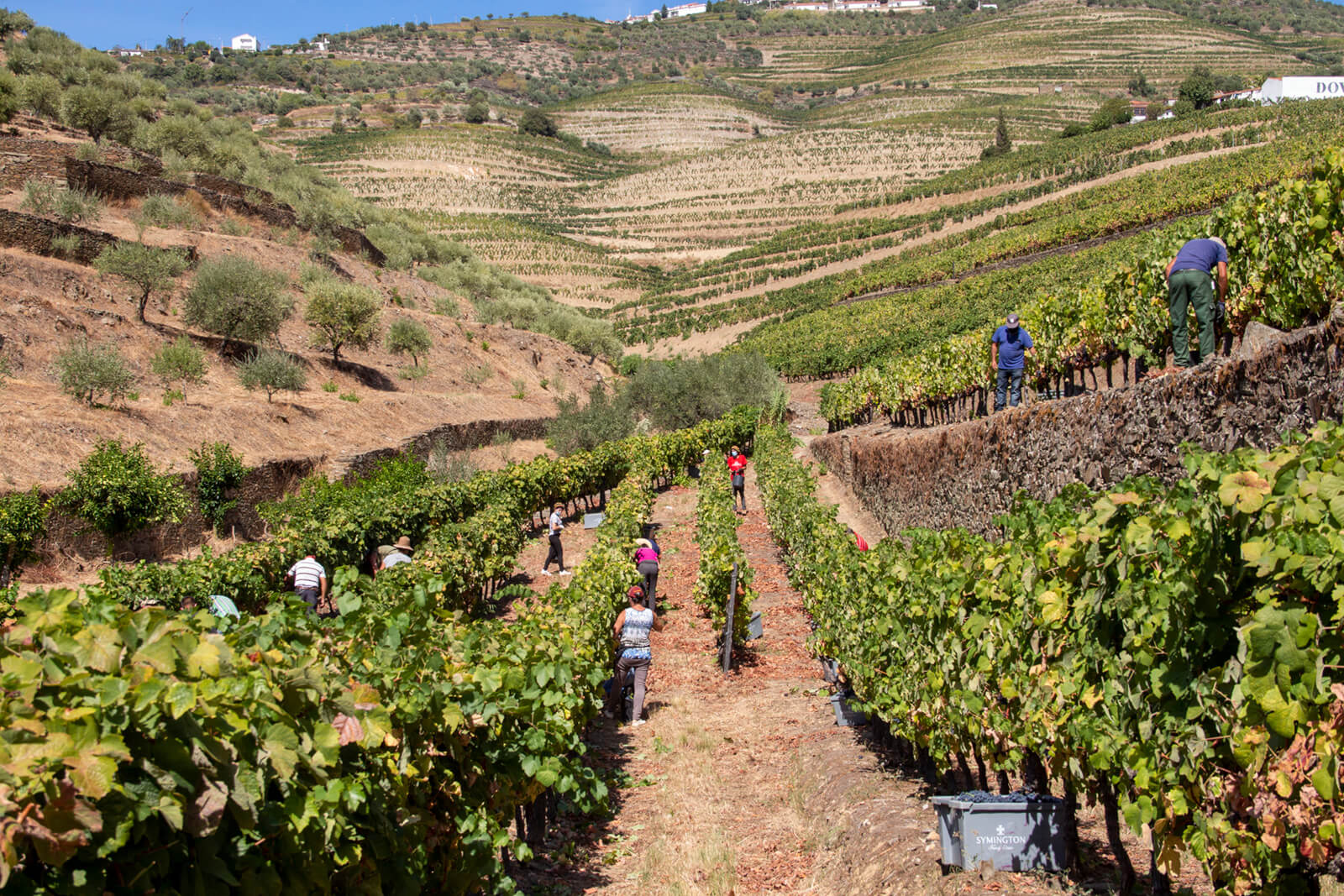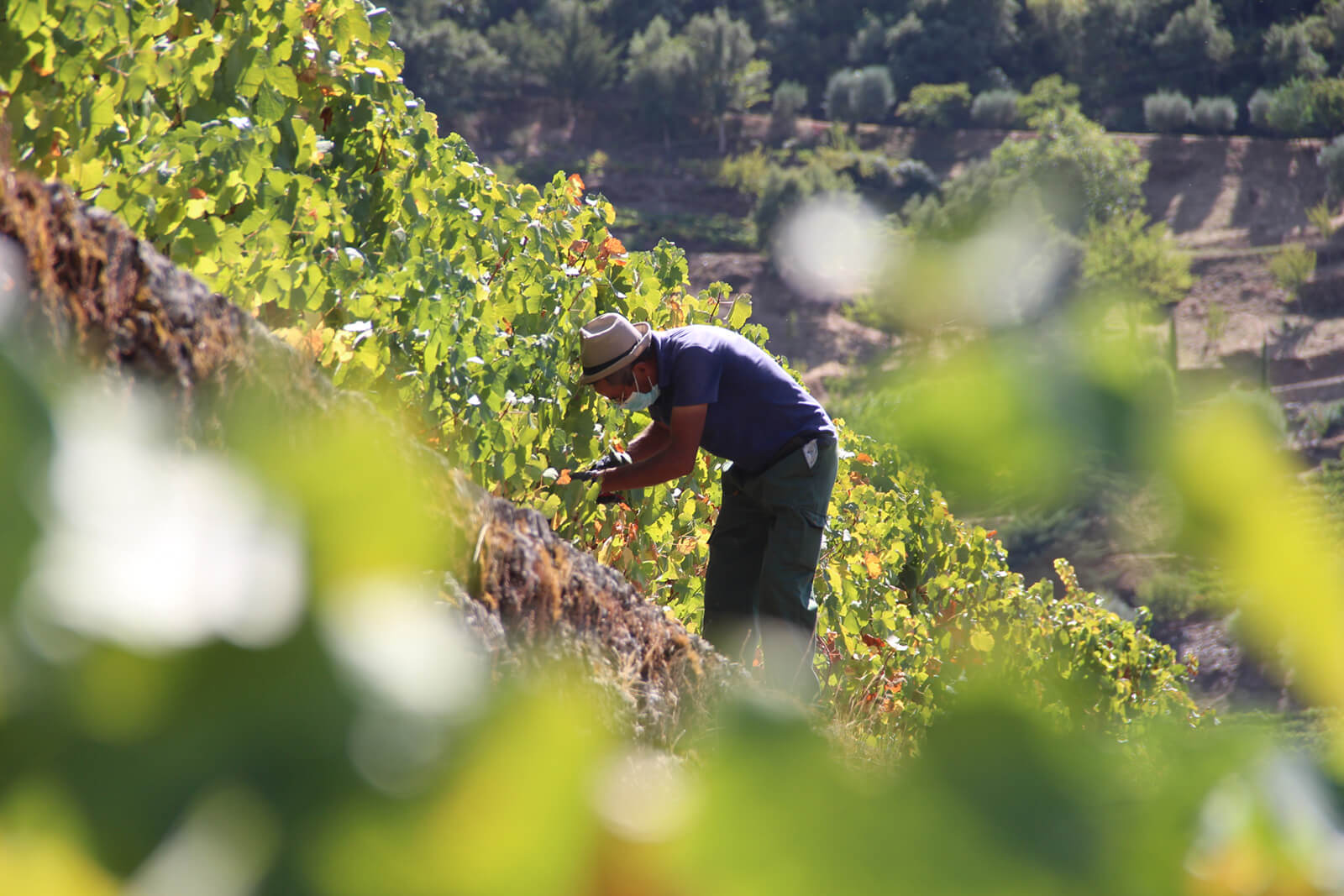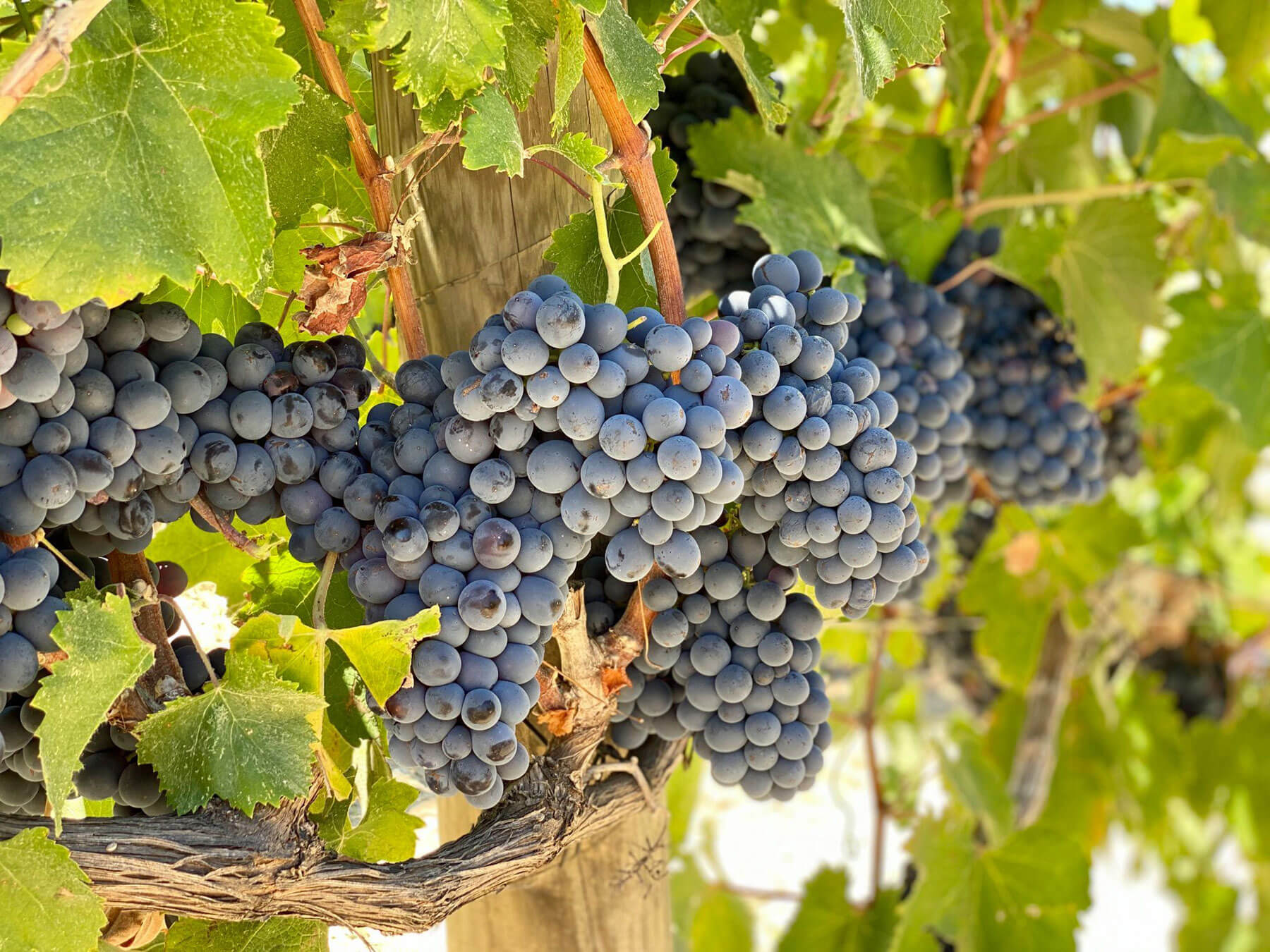
Der Jahrgang 2020
Italien, Frankreich & Portugal
Cantine Due Palme
Salento Apulien, Italien
»Vendemmia Memorabile!« Nur zwei Wörter bringen es auf den Punkt: An das Erntejahr 2020 werden wir uns gut erinnern. 2020 beschert uns etwas Außergewöhnliches – »un regalo straordinario«, das uns einen neuen Blick auf die Zukunft, mit neuen Verheißungen und Zielen ermöglicht; nach dieser schweren Pandemie, die ganz Italien in die Knie gezwungen hat. Alle mussten die Zähne zusammenbeissen, ihr standhalten und mit Entschlossenheit begegnen, mit dem für uns Süditaliener so charakteristischen Erfindungsgeist. Wir sind wie stämmige Bäume, so stark wie unsere Wurzeln, wir geben nie auf, halten durch, alle gemeinsam, dem schwersten Unglück trotzend. Covid 19 hat über unsere großartigen Weinberge nicht die Oberhand gewonnen, hat den Willen unserer Winzer nicht brechen können. Ganz im Gegenteil: Sie hatten während des Lookdowns mehr Zeit, um sich um um ihre Reben zu kümmern. Das Geschenk, das so viele Kräfte freisetzte und gleichfalls viele Befürchtungen und Ängste amortisierte, haben wir uns redlich verdient.
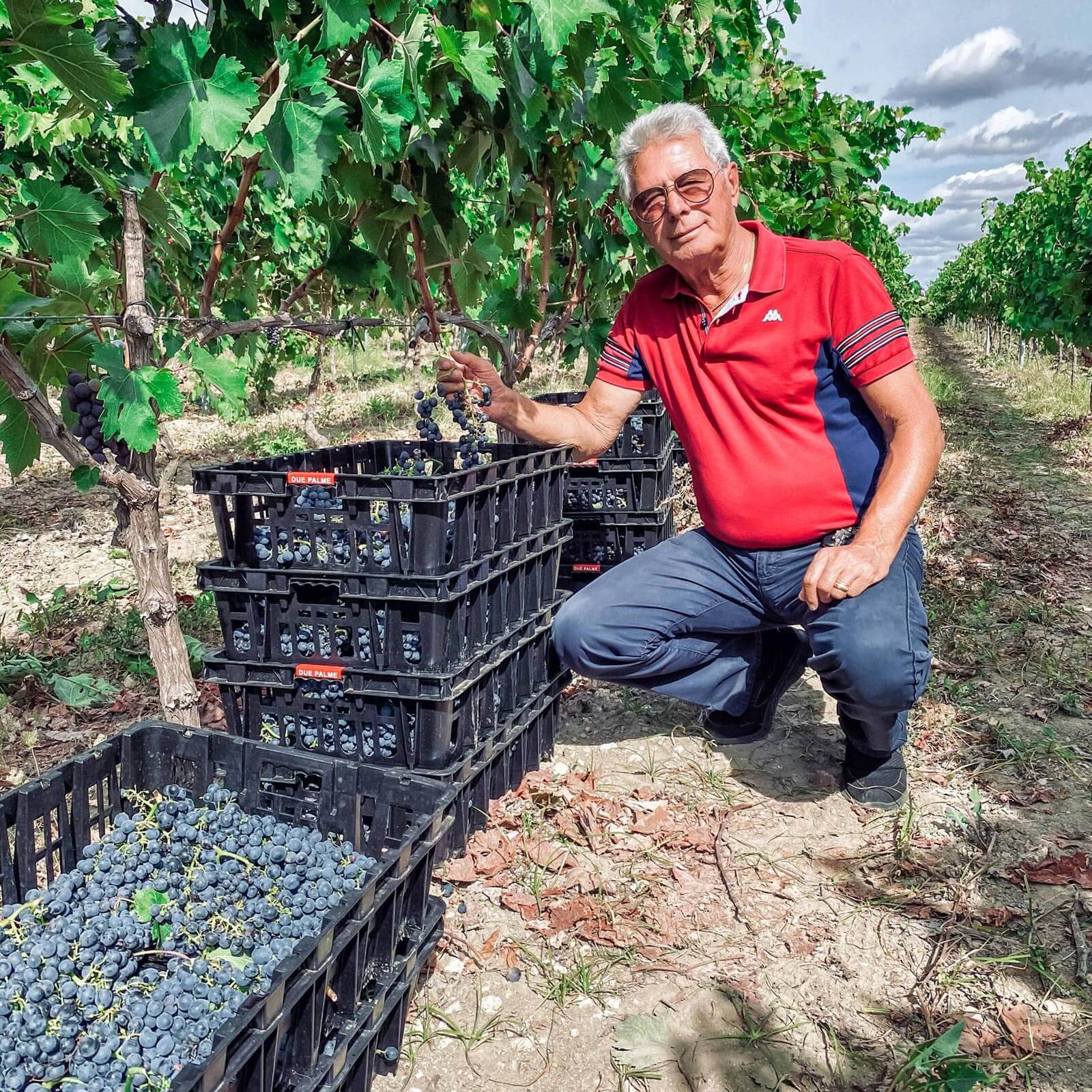
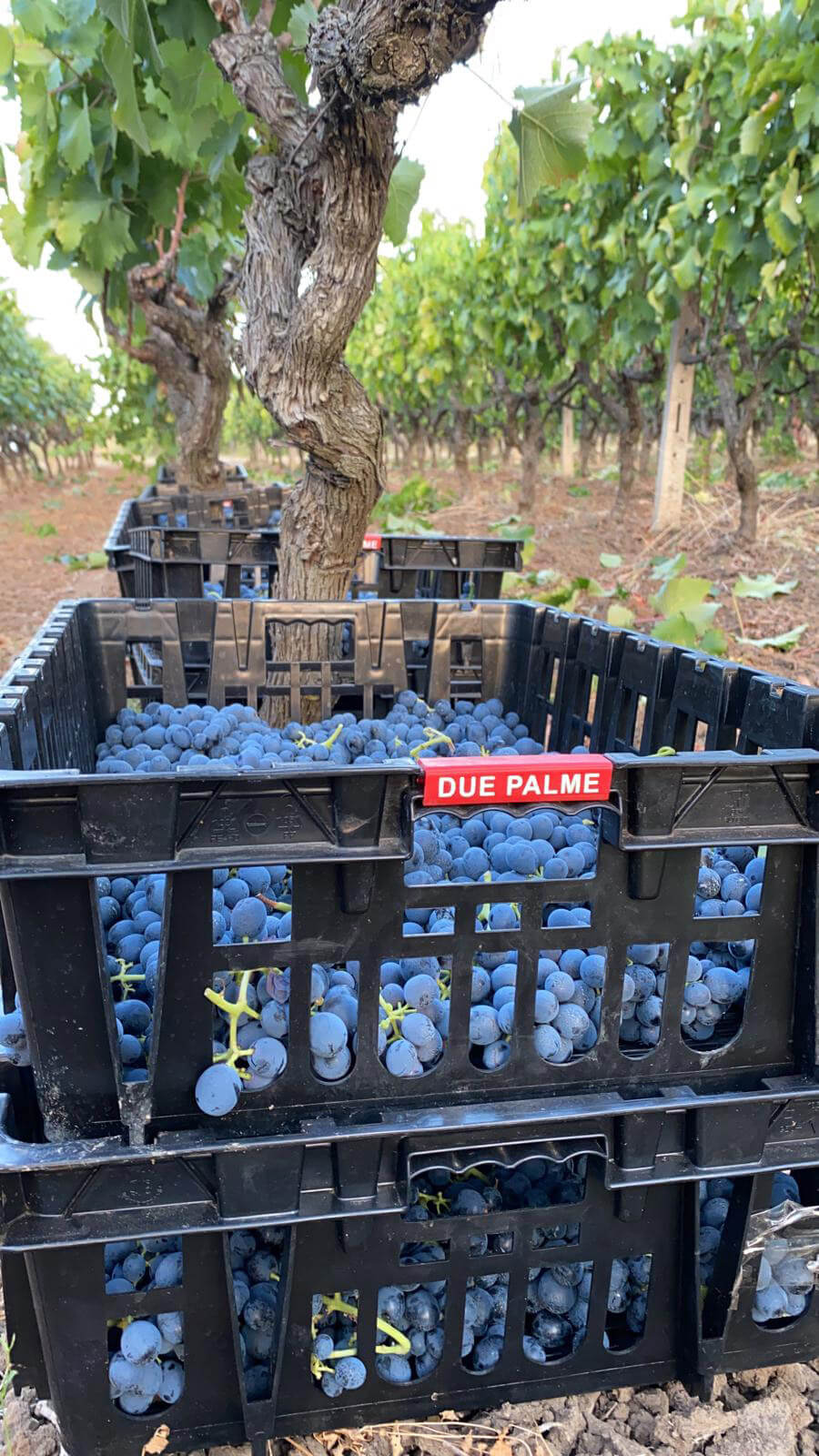
Auch das Klima war auf unserer Seite und hat bewirkt, dass wir völlig gesunde Trauben von erstklassiger Qualität ernten konnten. Diese Ernte hat 200.000 Zentner, davon 90 % dunkle Beeren eingebracht; einen durchschnittlichen Ertrag von 70/80 Zentnern heimischer Trauben wie Primitivo, Susumaniello, Negroamaro, Aleatico und Fiano. Das entspricht einem Zuwachs von 0,6 % gegenüber dem Vorjahr. Im Keller haben wir eine neue Technik der Vinifizierung eingeführt. Mithilfe eines »Dekanters« können wir schon in den frühesten Phasen der Weinbereitung einen klaren Wein erzeugen, indem wir einfach den Vorgang der Trennung der flüssigen von den festen Bestandteilen vorwegnehmen und so die Aromen konzentrieren.
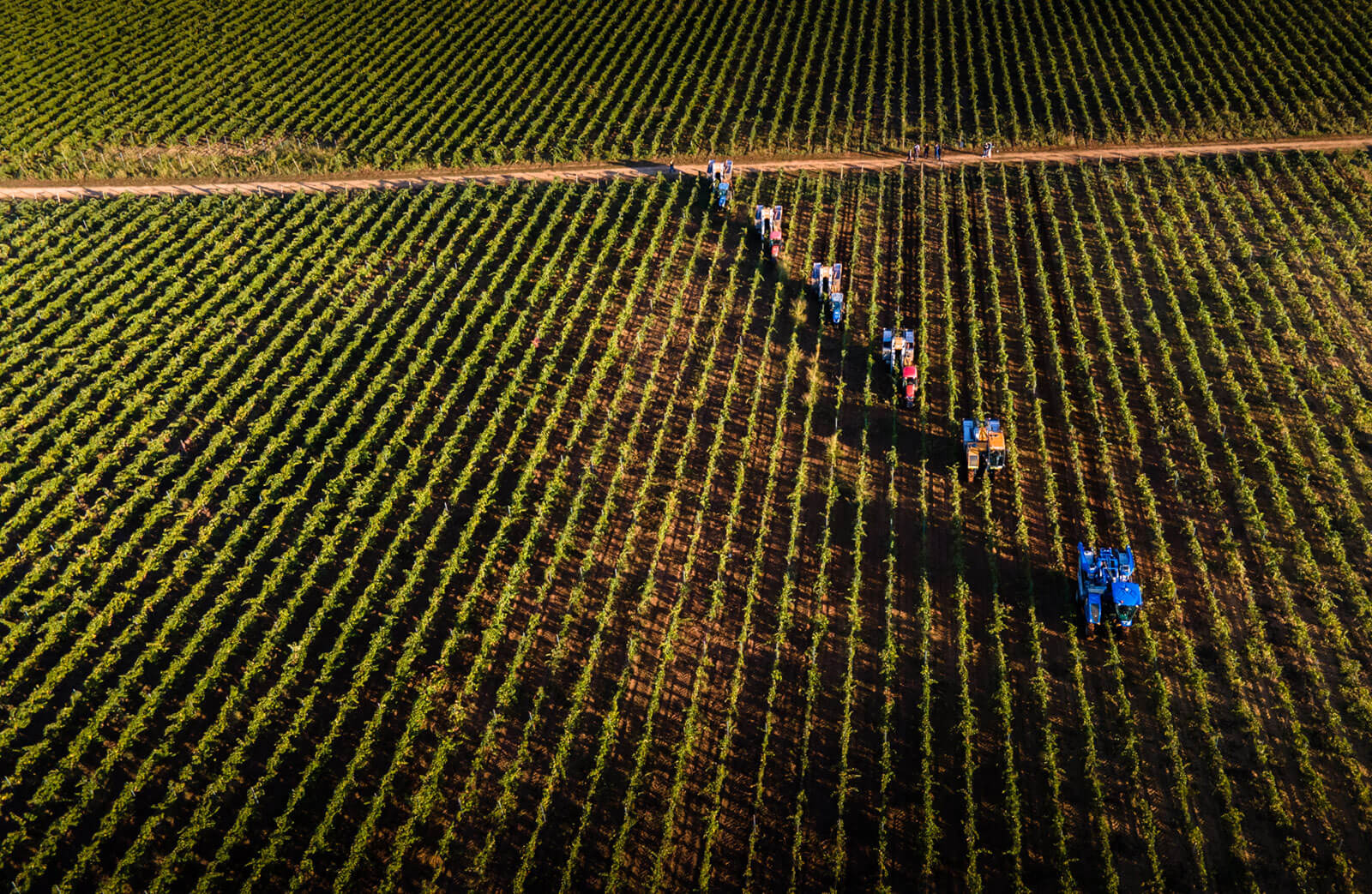
Diese neue Methode ist zudem umweltfreundlicher als die klassischen Vorgehensweisen bei der Klärung. Unser Präsident, Angelo Maci, ist davon begeistert. „Ein derart außergewöhnliches Jahr hatten wir seit 2007 nicht mehr, exzellent – und die Grundlage für Weine mit einer großen Struktur, die lange reifen können und als kostbare Kreszenzen in die Geschichte eingehen werden. Die Rebe braucht jetzt Ruhe und hier im Keller wird jetzt weitergearbeitet!“ Wir sind überglücklich und freuen uns schon darauf, bald auf den Jahrgang 2020 anzustoßen. Möge dieser Toast, dieses Zuprosten, nicht nur für Due Palme ein gutes Omen sein, sondern für den Salento, für Italien und die ganze Welt. Für uns, unsere Familien, unsere 1.000 Winzer und alle Kunden, die weiterhin sich für die Weine von Due Palme entscheiden.
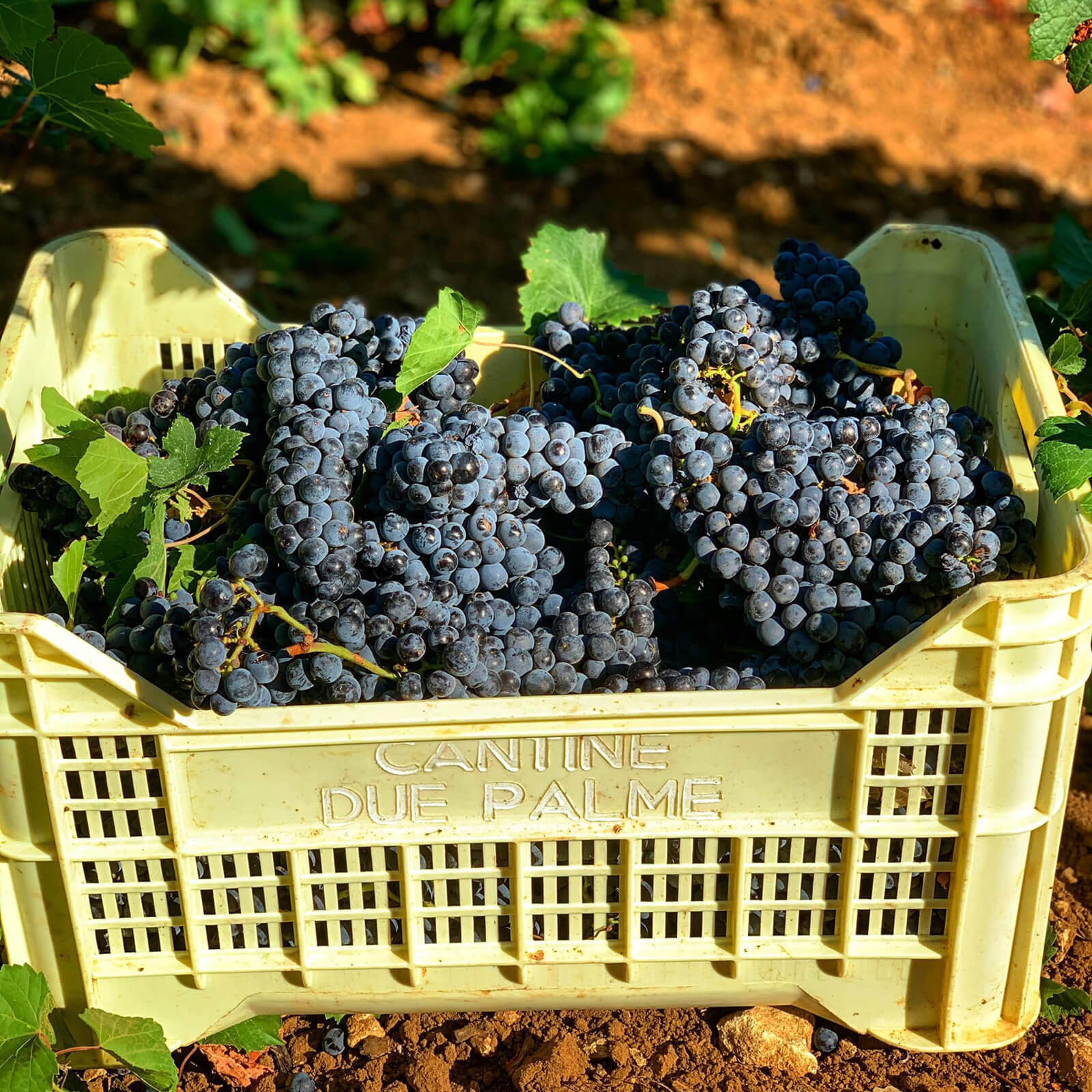
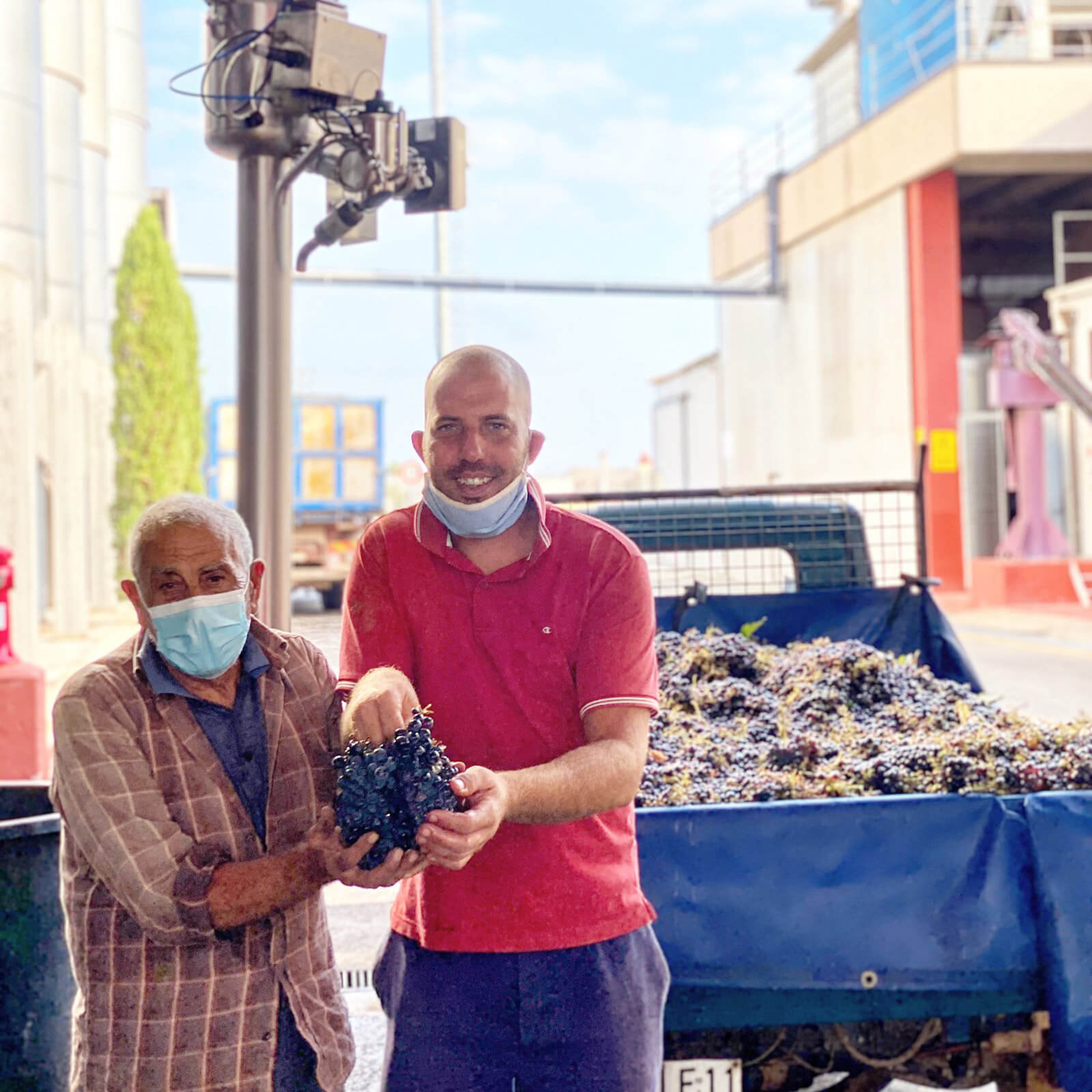
Poliziano
Montepulciano und Maremma Toskana,
Italien
Der Winter war von einem gemäßigt warmen Klima geprägt, was bereits Mitte März zu einer frühen Ausbildung der Knospen führte. Die vegetative Phase hingegen war durch ein kälteres Klima mit wechselnden Regenfällen während der Frühlingsmonate gekennzeichnet, eine sehr gute Grundlage für die Wasserversorgung im heißen Sommer! Der Sommer war sehr heiß, mit höheren Durchschnittstemperaturen als im langjährigen Mittel, außerdem sehr trocken, wodurch die Trauben früher reif wurden. Ende August setzte kurzzeitig starker Regen ein. Diese nötige Dusche schaffte es, die außergewöhnlich reifen Trauben mit einem optimalen Tannin-Säure-Gerüst zu versehen, und damit alles wieder in Balance zu setzen. Jetzt konnten optimale Trauben bei bestens geeignetem Wetter geerntet werden. In der letzten Erntephase, gegen Ende September, änderte sich das Wetter erneut und lang anhaltender Regen verlangsamte die Ernte, ohne jedoch die Qualität zu beeinträchtigen. Dies führte zu einem insgesamt „entspannteren“ Reifungsprozess und die letzten Trauben wurden eingebracht.
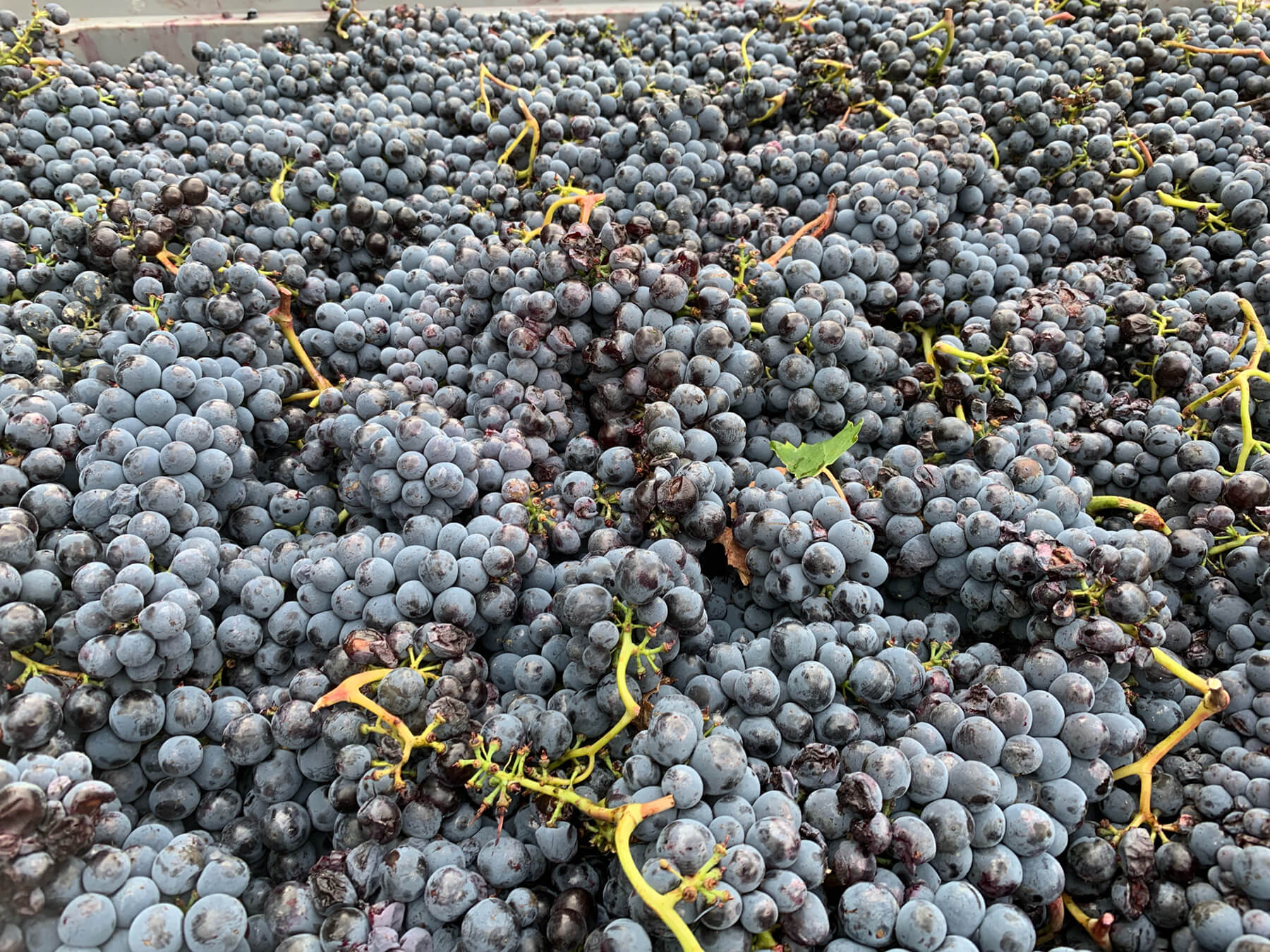
Zusammenfassend wird 2020 sicherlich ein Jahrgang werden, der mehr durch Qualität als durch Menge auffallen wird, zumindest dort, wo sich Winzer um optimale Traubenqualität und strenge Selektion bemüht haben. Bei den vor Ende September geernteten Weinbergen handelt es sich um Weine, die sich durch eine ausgeprägte Gerbstoffstruktur, aber auch durch eine optimale Länge und Vertikalität aufgrund des hervorragenden Säuregleichgewichts der Trauben auszeichnen werden, vorausgesetzt die saubere, präzise und sorgfältige Auswahl in den Weinbergen und im Keller. Die Weinberge, die nach den Regenfällen Ende September geerntet wurden, werden Weine mit kräftiger, jedoch deutlich runderer Gerbstoffstruktur, ihre Länge, Vertikalität und Säure werden im Kontext ausgewogener sein.
Altesino
Montalcino Toskana, Italien
Gott sei Dank gab es im November und Dezember 2019 ausgiebigen Regen, denn Januar und Februar waren zwar mild aber verhältnismäßig trocken. Ein plötzlicher Einbruch kontinentaler Polarluft aus dem Osten im März verursachte vereinzelt lokale Frostschäden. Die weiteren Monate blieb relativ mild mit geringem Niederschlag, auch der August war von überdurchschnittlich hohen Temperaturen und Trockenheit geprägt.
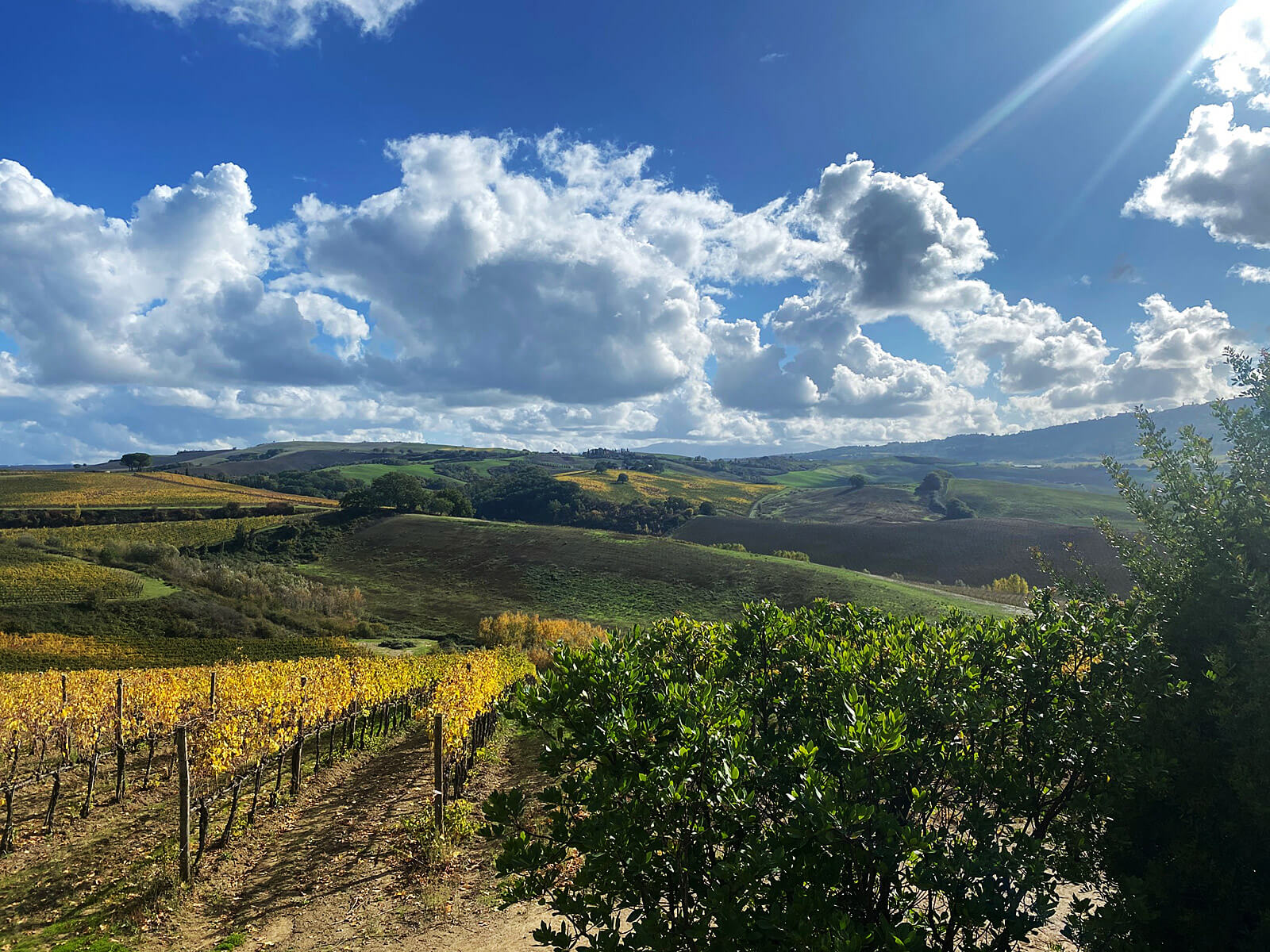
Trotz der wenigen Regenfälle und Hitzewellen blieben die Weinstöcke bis zur Ernte bei guter Gesundheit. Aufgrund eines frühen vegetativen Zyklus begann auch bei Altesino die Ernte viel früher als sonst. Wir freuen uns über »warme« Weine mit einem recht hohen Alkoholgehalt, ausgezeichneten Extrakten und einer aromatischen Komplexität, was typisch für die heißeren Jahrgänge ist.
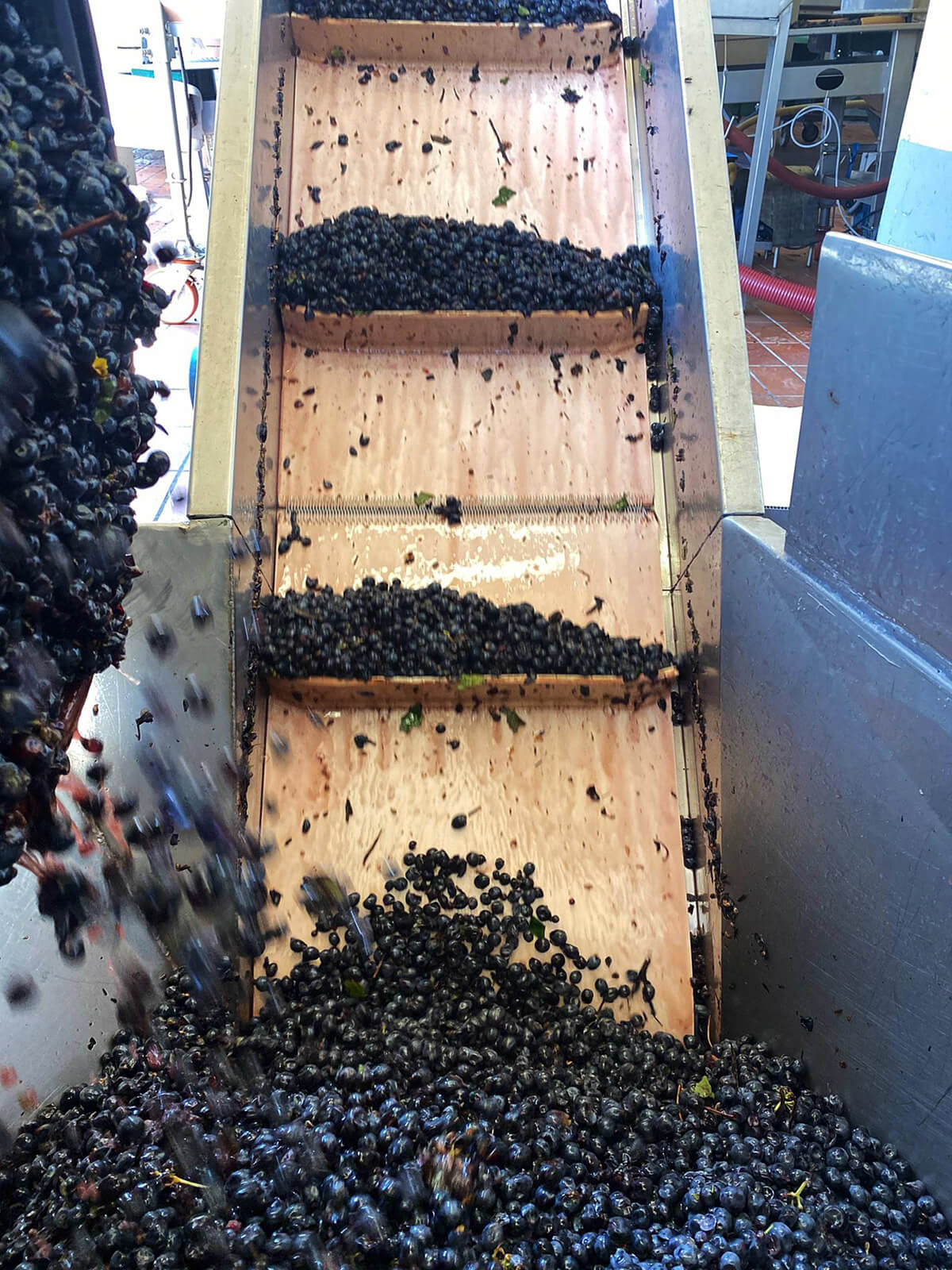
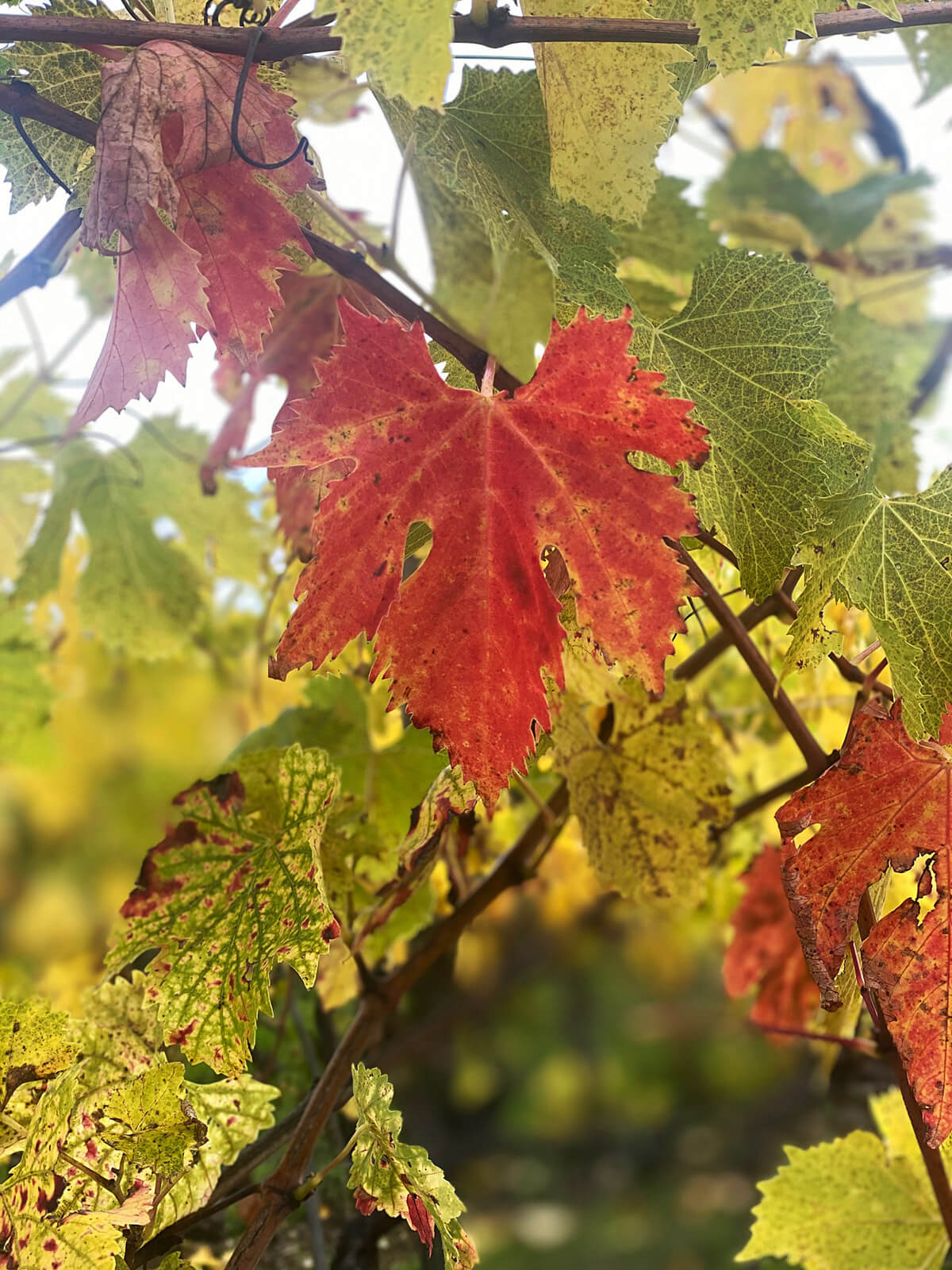
Vendemmia 2020 – Andamento Generale
Il 2020 inizia con una buona riserva idrica nel terreno grazie alle copiose piogge di Novembre e Dicembre 2019. Gennaio e Febbraio sono risultati molto miti e con precipitazioni scarse in tutti le zone della nostra azienda.
Marzo ha invece goduto di una piovosità in genere abbondante e accompagnata da temperature nella norma, eccezion fatta per il brusco calo delle temperature registrato a partire dal 24 marzo a seguito di un’irruzione di aria polare continentale da Est, che ha prodotto locali danni da gelo anche sulla vite.
Temperature miti e piovosità scarsa hanno caratterizzato aprile e maggio, mentre giugno ha presentato temperature lievemente inferiori alla norma con piovosità sempre sotto la norma. Agosto ha infine presentato temperature superiori alla norma cui si è accompagnata una piovosità generalmente scarsa se non in certi casi assente.
Dal punto di vista fitosanitario i vigneti sono arrivati alla vendemmia sani e nonostante le poche piogge e le ondate di calore anche in buona salute.
A causa di un ciclo vegetativo precoce , anche ad Altesino la raccolta è iniziata con un notevole anticipo.
Anche quest’anno sono state effettuate importanti operazioni agronomiche che hanno fatto la differenza nel salvaguardare la qualità della produzione :
• Durante la fase di accrescimento dell’acino e di chiusura del grappolo operazioni come la sfemminellatura e la defogliatura parziale sono state mirate solo in quelle microaree più vigorose o dove l’assenza di piogge non ha creato problemi di stress sulle piante.
• Il diradamento dei grappoli è stato effettuato solo in particolari casi sempre legati alla vigoria della pianta . Anche quest’anno la lotta fitosanitaria ha visto l’utilizzo di metodi di difesa utilizzati in agricoltura biologica/biodinamica : confusione sessuale per il controllo della tignoletta (lobesia botrana) e zeolite per tenere asciutto il grappolo soprattutto nelle prime fasi vegetative. Su alcuni vigneti, vista la particolare annata con poche piogge, la lotta fitosanitaria è stata effettuata solo con metodi biologici tra cui rame e zolfo, zeolite, bacillus, estratti di mandarino.
La vendemmia è iniziata con i vitigni bianchi, con almeno una settimana di anticipo rispetto al 2019.
Lo stesso anticipo si è verificato nel Sangiovese. La vendemmia è iniziata nella prima decade di Settembre nei vigneti di Pianezzine per poi proseguire nel versante nord di Montalcino con i vigneti di Macina ed alcuni appezzamenti di Altesino. Nella terza settimana sono state raccolte le uve di Montosoli e successivamente i vigneti della Velona, per poi finire con gli appezzamenti più tardivi intorno al centro aziendale.
Si sono ottenuti vini caldi, molto alcolici, con estratti eccellenti e complessità aromatiche tipiche delle annate più calde.
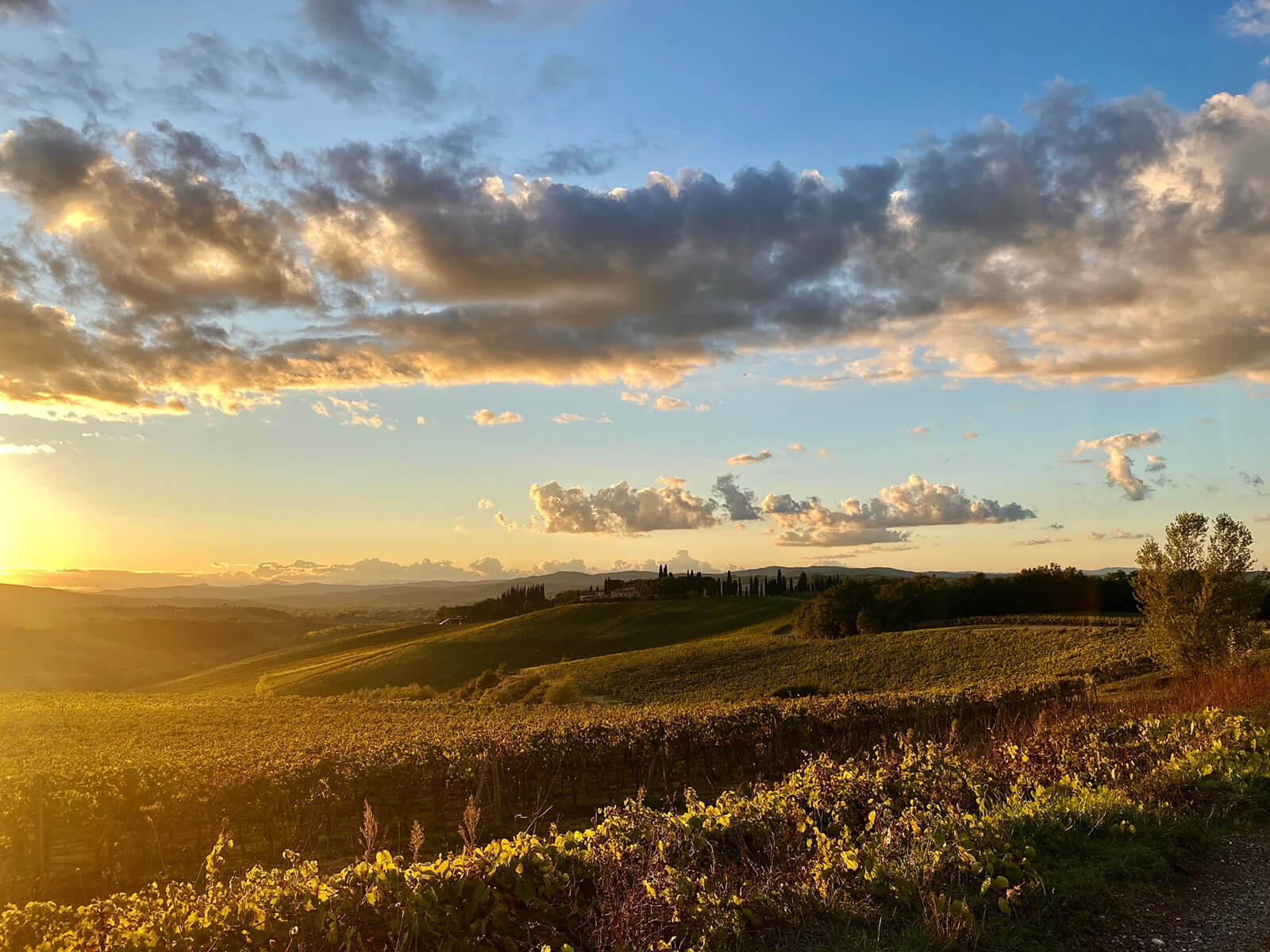
Foradori
Trentino, Italien
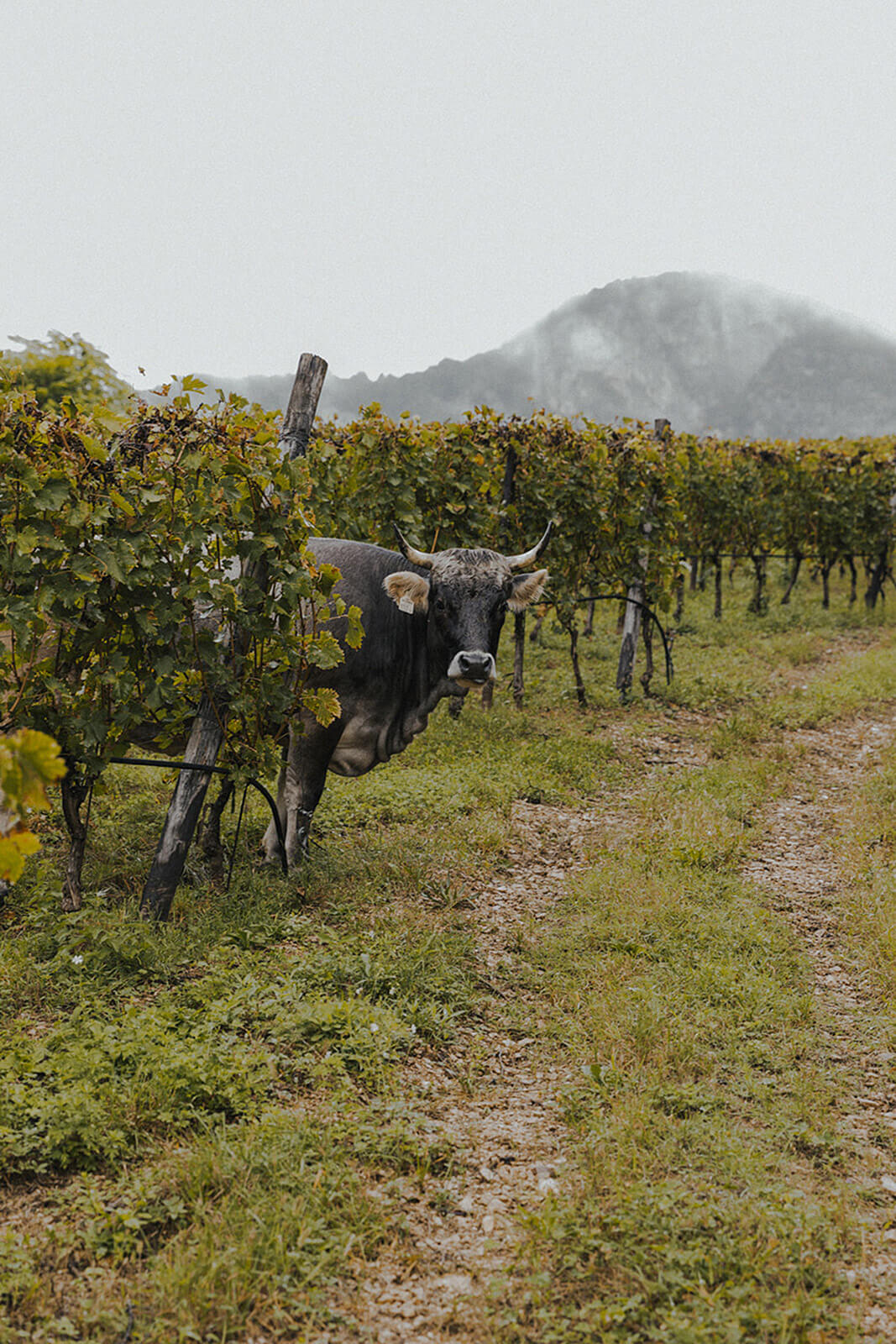
Harvest 2020: surreal times, surprising wines
Winter started with a lot of snow, conditions for powder- skiing were fantastic in the first part of the season: we had a lot of fun! As fast as the snow came, spring followed. A quite early budbreak announced a typical climate change vintage: early spring- early harvest- Mediterranean conditions in the Alps. But things turned out a bit different. We have the chance to live in this surreal time of history and discover a lot of surprises, such as this vintage was for us.
Spring was warm vines were growing fast, same things in the early summer: a regular flowering started May 25th. We had very consistent rainfall, plants had always perfect growing conditions. We had a huge potato crop, chard and lettuce were fantastic. Unfortunately, this was also the case for mushrooms: Mr. Powdery Mildew had a great time. Because of Europe’s Covid19 restrictions and the scarce airplane traffic in our skies, weather forecasts were a disaster. Up to 30% of the weather data comes from aviation. No planes means no information, means wrong forecasts. The application of our biodynamic preparations as well as cupper and sulfur treatments are a high precision job. If weather conditions are not as expected, the efficacity of products is very low. It sounds crazy, but the lack of airplanes flying around turned to be a problem for a biodynamic farm like us. We lost 15% of our grapes because of wrong weather forecasts.
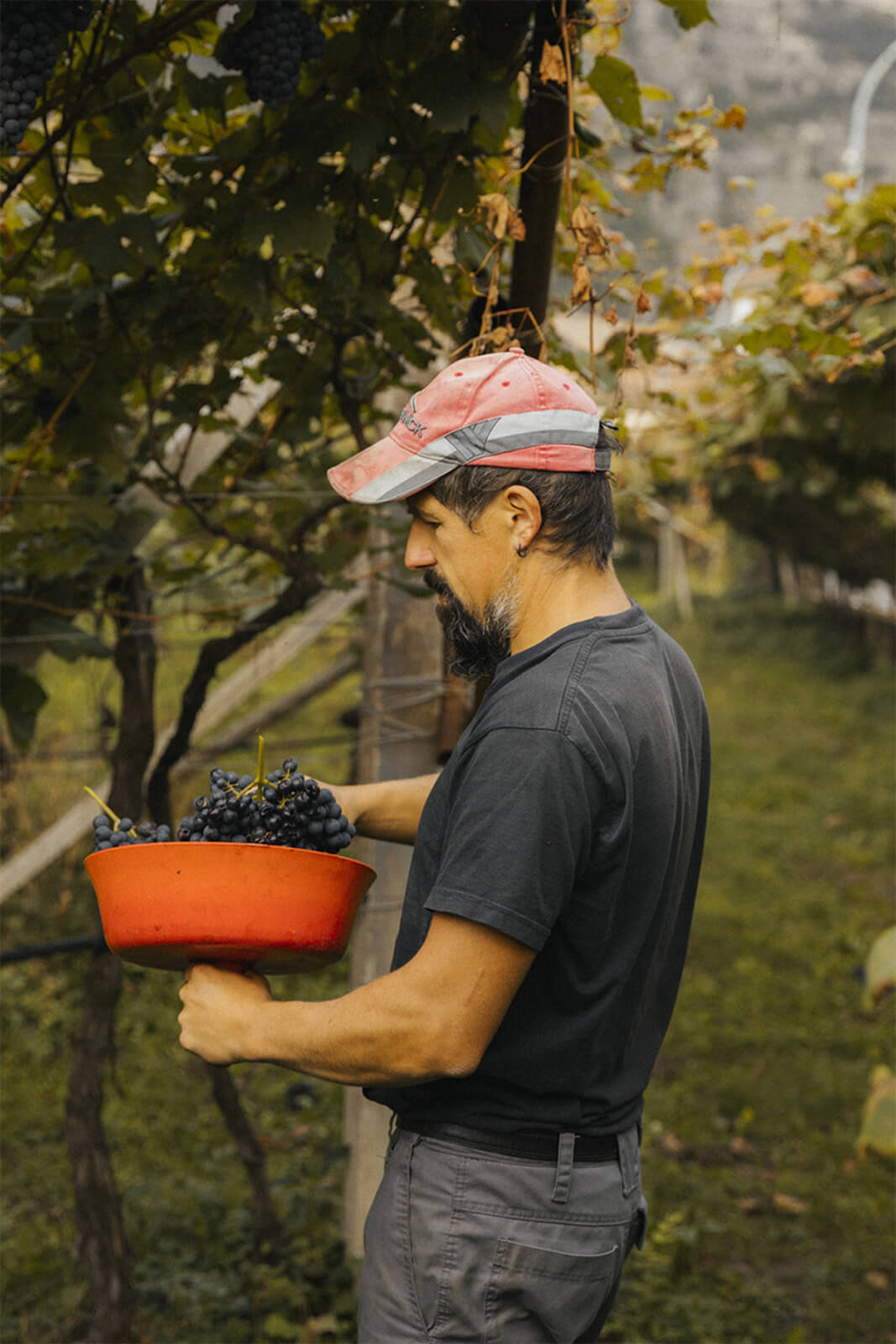
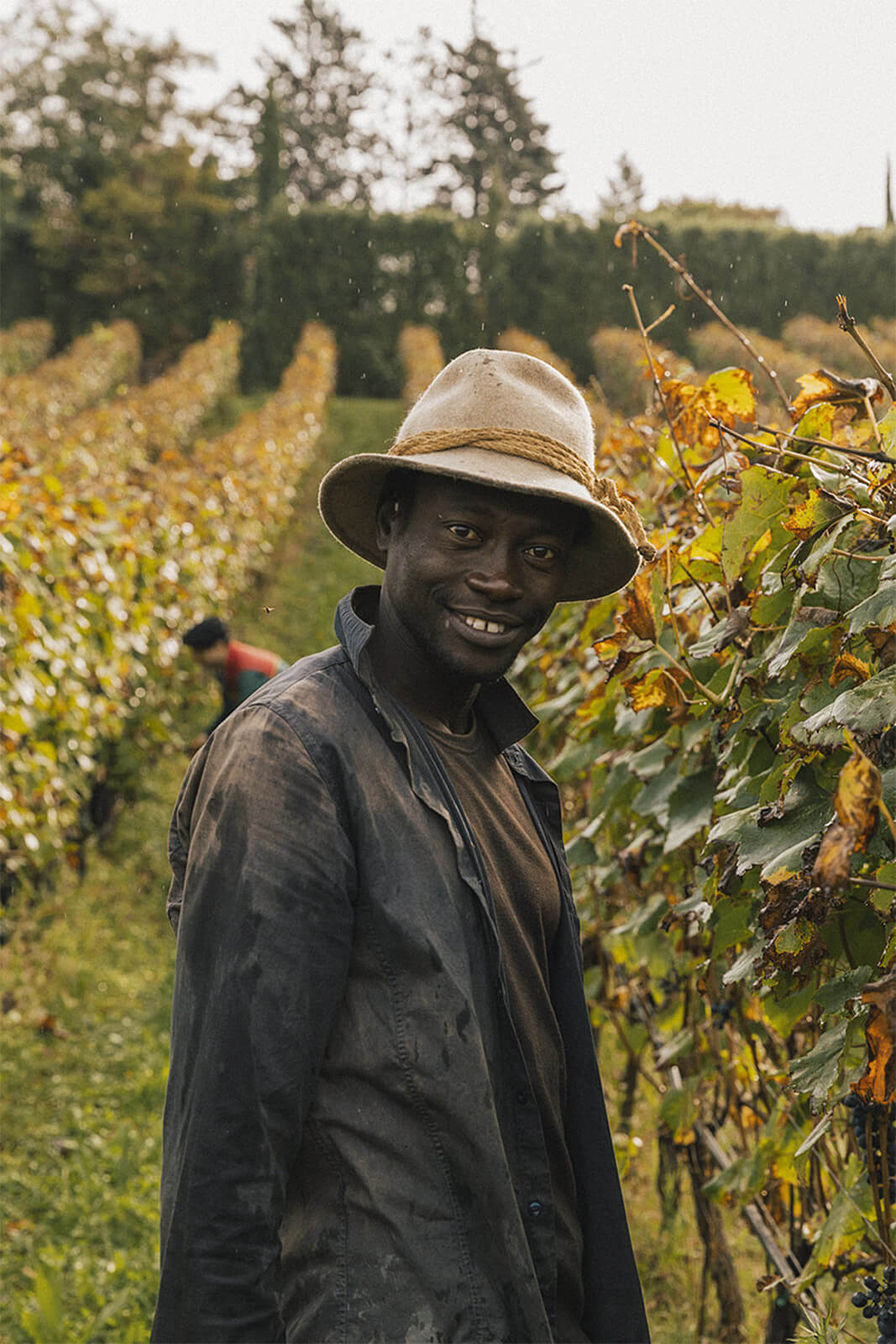
July was not too hot, August was wet. Unfortunately, very wet. Heavy rains in early September scared us a lot, some bad memories of the horrible 2014 vintage were present. Fortunately, only in our minds. After the rain we had a very warm September with high temperatures during the day. Night temperatures were medium-low. This dry but not ideal weather conditions in September saved our harvest: all varieties reached good maturity levels in sugar and phenolics.
We started picking Pinot Grigio August 26th and finished with Teroldego on September 30th. In the cellar yeast activity was incredible: especially in the first half of the harvest on whites. We had fast fermentations with a high ratio of transforming sugar into alcohol. I personally have never seen such a spectacle: values of yeast- propagation were up to 5 times higher than our normal values. To resume it in simple words: this was the biggest orgy we ever had in our cellar.
In the second part of the harvest yeast- activity calmed down a lot (things that start fast, usually are finishing slow) fermentations were calm, but consistent, in some cases very calm.
Pinot Grigio was for sure the biggest surprise of this vintage. We were simply astonished, how our Pinot Grigio was able to handle a huge quantity of rain in August and the beginning of September. Like all Pinots, Pinot Grigio has not a very thick skin, it is a quite compact grape, which is very sensitive to botrytis and sour rot. This was not the case on our Pinot Grigio. Grapes were healthy, there was a beautiful texture and tension in the must, which gave us very balanced wines.
Manzoni Bianco was harvested in two steps: an early harvest the last week of August in the lower part of Fontanasanta and a later one around September 10t in the higher part of the estate. The wines are very different but complementary. Wines are showing a lot of clarity, brightness and varietal notes. We are curious about their evolution.
Nosiola was very generous this year. While we lost up to 15% of the crop because of powdery mildew on all the other varieties, Nosiola overperformed. This was a great chance, because we were able to pick in three steps, selecting each time the ripest grapes. Malos are still marching on. All elements are there to have a complex and deep Nosiola.
Teroldego was the second big surprise. As mentioned before, in the beginning of September we seemed to have another 2014- nightmare on reds. Our biggest concern was the phenolic maturity. Until mid of September everything tasted like grass. Tannins were harsh and green, skins were thin. Thanks to the hot weather in September a revolution of photosynthesis happened. In 10 days, the scenario turned completely. We harvested end of the month fully ripe grapes with great complexity. There is not the tension and deepness of the 2019, but there is for sure a little miracle of nature in these grapes and wines. The first Teroldegos after fermentation are charming and round, we are waiting the end of fermentation of our old pergolas to have a wider picture.
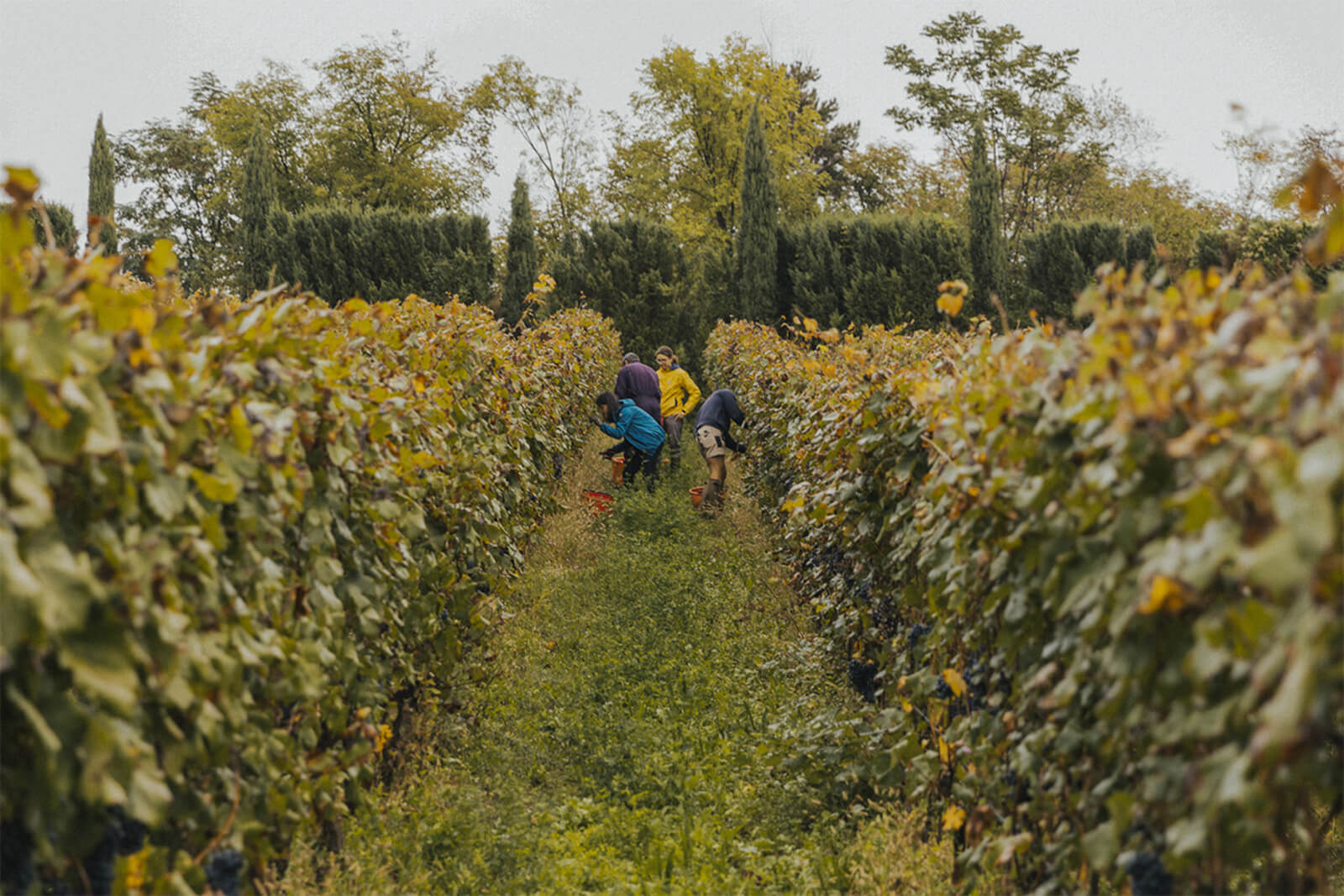
Champagne Deutz,
Champagne, Frankreich
Von Oktober bis Anfang März waren die Mengen an Niederschlägen viel zu hoch: Die Champagne verzeichnete für diesen Zeitraum ungefähr 500 mm an Regen. (Normalerweise sind es in der Region im Schnitt 600 mm pro Jahr!) Lenkt man seinen Blick auf das Gute daran, ist zu sagen, dass der Grundwasserspiegel im Vergleich zum Vorjahr richtig gut dasteht. Die Temperaturen wiederum waren mild. Zu Morgenfrost kam es nur selten. Beim Winter 2020 handelt es sich im Übrigen um den mildesten, den der französische Wetterdienst Météo France seit mehr als einem Jahrhundert aufgezeichnet hat.
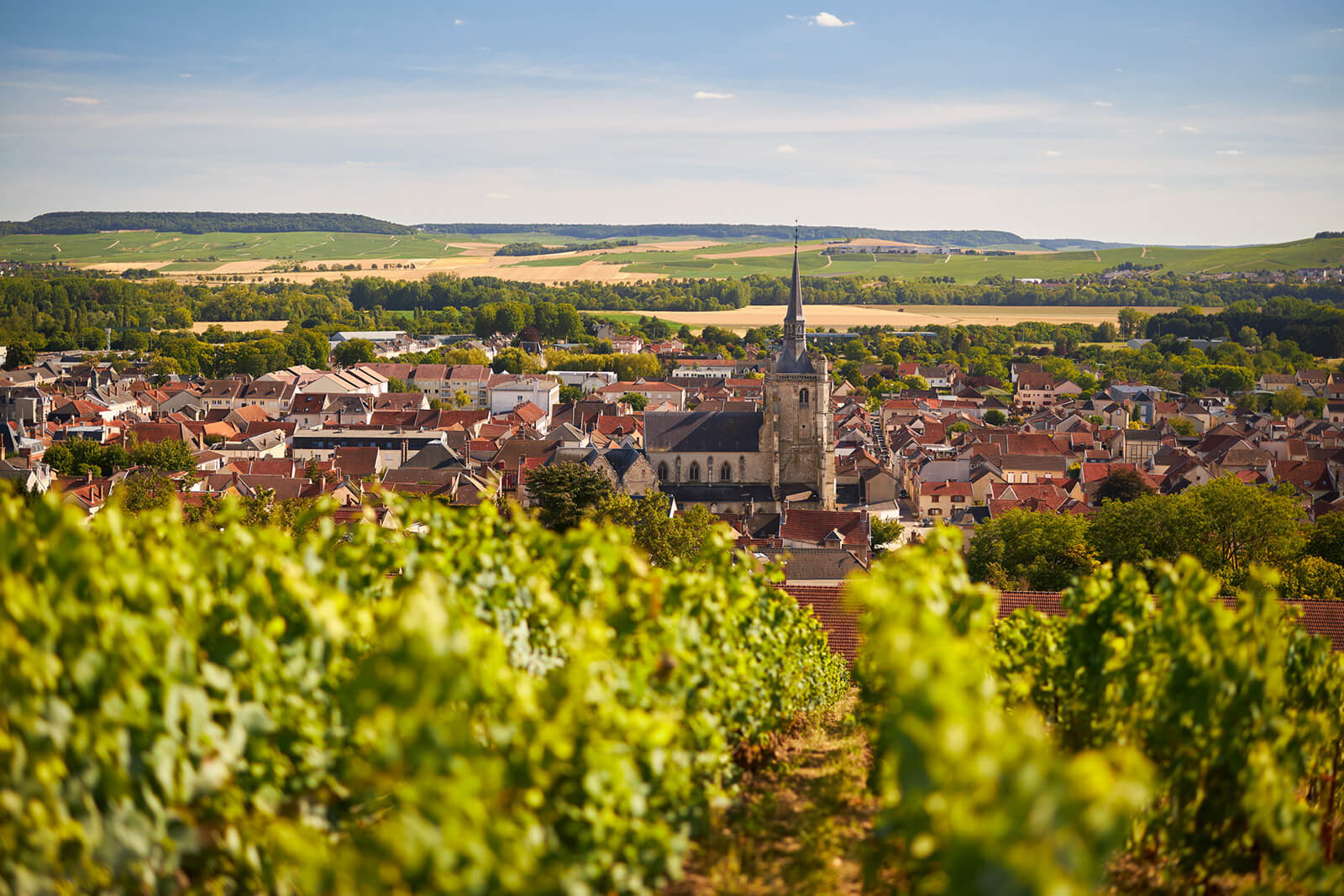
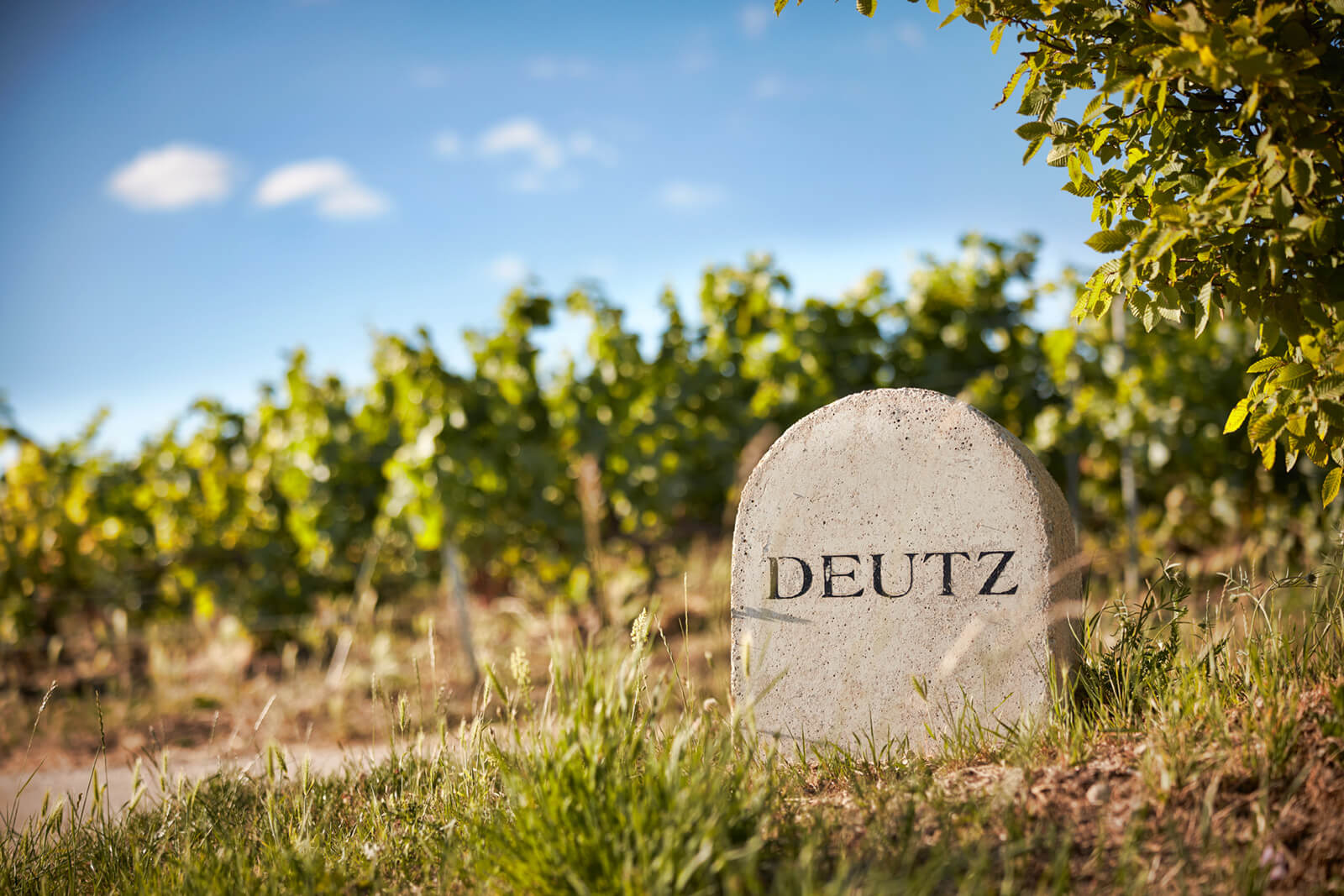
Manuelle Arbeiten und insbesondere der Rebschnitt fanden unter diesen Bedingungen pünktlich statt. Die Traktoren kamen diesen Winter dagegen nur wenig zum Einsatz. Kurz vor Frühjahresbeginn verzeichneten wir daher bei der Bodenarbeit eine sehr große Verzögerung. Im März dominierte leider Covid-19 die Nachrichten. Zu wettermäßig schönen Tagen kam es wieder ab dem französischen Lockdown. Da man Weinbau nicht in Telearbeit betreiben kann, passte sich Deutz an die Gegebenheiten an, was z. B. weniger Teamarbeit, weniger Aufenthalte in der Halle, kein Teilen von Material sowie die rigorose Einhaltung von Hygienevorschriften bedeutete. Die Arbeit mit den Trauben konnte fast so wie sonst auch durchgeführt werden. Während die Böden allmählich austrockneten, wurde der Rückstand an mechanischen Arbeiten (Häckseln, Ausbringen von Dünger und vor allem Bodenbearbeitung) recht schnell aufgeholt. Mit dem endgültigen Verzicht auf Pflanzenschutzmittel auf den hauseigenen Parzellen wurde das mechanische Jäten des Bodens zu einer der zeitaufwändigsten Aufgaben. Da die Temperaturen im März so hoch waren wie in diesem Winter, ist es nicht verwunderlich, dass die Reben gut zehn Tage früher austrieben als im Zehnjahresdurchschnitt. Für die Weinberge des Hauses Deutz handelte es sich beim Chardonnay, beim Pinot Noir und beim Meunier um den 7., den 9. und den 12. April.
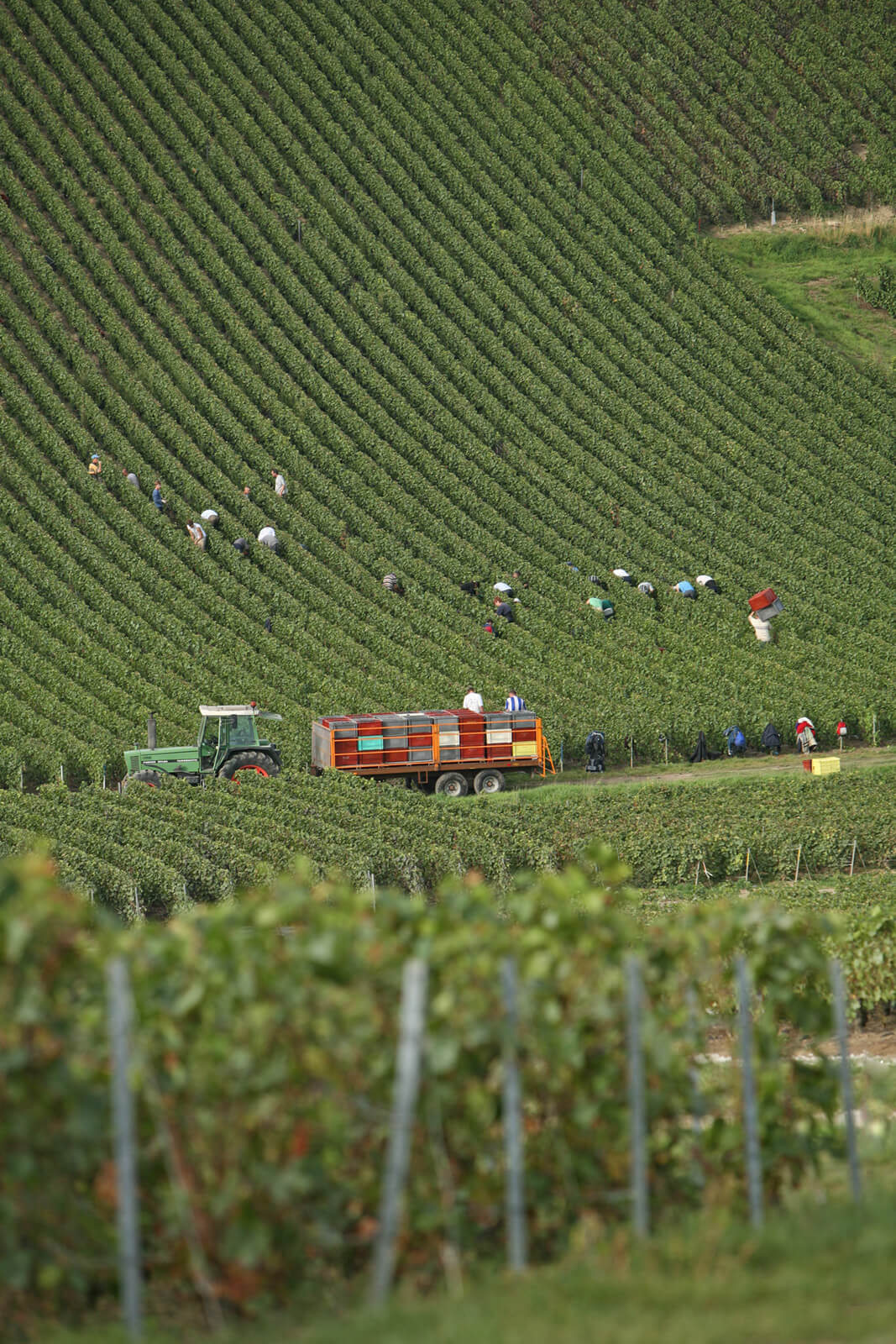
Der April gab sich fast sommerlich und stand ganz im Zeichen der Verjüngung der Weingärten. So kam es auf etwa 2 Hektar zu Neubestückungen. Die Neuheit des Jahres: Alle Pflanzungen auf dem Weinberg des Hauses Deutz wurden mit einer zentimetergenauen Navigation durchgeführt. Karrees wurden mit einer Mapping-Software generiert. Bleibt nur noch, die Lage der Wege mit einem GPS abzustecken. Im Gegensatz zu vorhergehenden Jahren wurden alle Pflanzungen von hauseigenem Personal vorgenommen. Dabei kam es zu einer hervorragenden Zusammenarbeit zwischen verschiedenen Abteilungen: Angestellte aus Verwaltung und Vertrieb unterstützten ihre Kollegen und Freunde im Weinberg.
Die Wachstumsdynamik hielt bis zur Zeit der Eisheiligen (vom 11. bis zum 13. Mai) an, bis es zu einer deutlichen Abkühlung kam. Zu Frost kam es nur fast, manche Blätter erlitten durch die niedrigen Temperaturen leichte Schäden. Innerhalb nur eines Tages sank das Thermometer um 20 °C. Die niedrigen Temperaturen traten jedoch nur vorübergehend auf und hatten auf die Reben nur wenig Einfluss, da die Böden Wärme gespeichert hatten. Festzustellen war lediglich eine leichte Verlangsamung des Wachstums. Mit der Relevage wurde bei den ersten Parzellen am 14. Mai begonnen, also drei Wochen früher als normal.
Die Blütezeit begann, sobald die Temperaturen wieder so waren, wie es für die Jahreszeit üblich ist. Patrick Boivin, der für den Weinberg verantwortlich ist, und sein Stellvertreter Cédric Georget notierten für die volle Blüte des Chardonnay den 26. Mai sowie für den Pinot Noir den 28. Der Meunier, welcher sich auf späteren Lagen befindet, blühte dagegen erst am 30. Wenn wir von einem durchschnittlichen Zeitraum von 90 Tagen zwischen Blüte und Weinlese ausgehen (ein Zeitraum, der mit der Klimaerwärmung tendenziell abnimmt), deutet eine Blüte Ende Mai auf eine Ernte Ende August hin. Der gesundheitliche Zustand der hauseigenen Weingärten sowie der unserer Partner blieb die ganze Zeit über gut. Die Gefahr von Falschem Mehltau belief sich aufgrund der Sonneneinstrahlung sowie der niedrigen Niederschlagsmengen auf fast null. Günstig war die Zeit dagegen eher für Echten Mehltau. Dennoch waren unsere Parzellen mit Chardonnay (die empfindlichsten) in einem hervorragenden Zustand. Die beiden Ende Juli bzw. Anfang August verzeichneten Hitzeperioden verursachten vor allem an roten Rebsorten Hitzeschäden. Betroffen waren etwa 30 % der Trauben mit Verlusten von 10 bis 15 %. Der Wassermangel in den Monaten Juli und August löste in einigen Teilen des Weinbergs sichtbaren Wasserstress aus. Einzelne Reben, Teile von Parzellen oder sogar ganze Parzellen wiesen charakteristische Symptome auf (Gelbfärbung der Blätter und allmähliches Austrocknen von unten nach oben). Auf Kreideböden ist dies sehr selten und zeigt die sehr trockene Charakteristik des Jahrgangs 2020.
Was den Ertrag betrifft, erlaubte es der Wassermangel den Beeren nicht, so zu wachsen, wie sie es sollten. Die Erträge sind daher niedriger als vorher geschätzt. Ganz wie der Rest des Jahres war die Reifedynamik auch eher einzigartig. Die ersten beiden Augustwochen ging sie mit mehr als 2 % Vol. innerhalb einer Woche rasant voran. In der dritten Woche hielt sie dann inne, um danach umso besser voranzuschreiten. Selten ist außerdem der Unterschied im Hinblick auf den Reifegrad von Chardonnay und Pinot Noir bzw. Meunier. Für die Weinlese ein optimales Datum festzulegen war daher nicht einfach.
Die ersten Lesescheren kamen am 22. August in unseren Weingärten in Aÿ und Pierry zum Einsatz. Einen so frühen Zeitpunkt gab es im Hause Deutz noch nie! Zwischen Blütezeit und Ernte lagen damit 2020 nur 86 Tage, womit ebenfalls ein Rekord gebrochen wird. Der Gesundheitszustand der Trauben war ausgezeichnet, sie waren – wie in zahlreichen anderen großen Jahren – schön ausgereift. Nach 10 Weinlesetagen beläuft sich der Ertrag auf 8 800 kg/ha (400 kg mehr als die Entscheidung des Comité Interprofessionnel du Vin de Champagne). Kellermeister Michel Davesne und sein Stellvertreter Olivier Bernard beobachteten bei der Pressung eine gute Ausgewogenheit der Mostwerte: im Schnitt 10,6 % Vol. potenziellen Alkohol. Besonders freuen sie sich über die hervorragenden Werte der besten Parzellen in Aÿ, wie die der Côte Glacière (11,2 % Vol. potenzieller Alkoholgehalt – 5,6 g/L H2S04) oder von Meurtet (10,8 % Vol. potenzieller Alkoholgehalt – 6,2 g/L H2S04). Die Grands Crus des Chardonnay in Avize (10,6 % Vol. potenzieller Alkoholgehalt – 5,9 g/L H2SO4) oder Oger (10,6 % Vol. potenzieller Alkoholgehalt – 7 g/L H2SO4) geben sich ebenfalls vielversprechend. Den höchsten Alkoholgehalt erreichte mit 12,1 % Vol. ein Trester aus Mareuil. Für die Weinbereitung steht also eine herrliche Materie zur Verfügung, aus der ganz sicher eine wunderbare Quintessenz gewonnen werden kann. Die Bedingungen verheißen einen Jahrgang von hervorragender Qualität, welcher Hoffnung auf ziselierte Jahrgangsweine macht und vielleicht sogar ein prestigeträchtiges Trio (William Deutz/Amour de Deutz und Amour de Deutz Rosé) sowie Parzellenweine Hommage à William Deutz in Aussicht stellt. Mit einem Lächeln erinnert Generaldirektor Fabrice Rosset jedoch daran, dass die Entscheidung hierfür nächstes Frühjahr während Verkostungen bei den guten Tropfen selbst liegt.
Laden Sie sich hier den deutschen und hier den englischen Erntebericht als Pdf herunter.
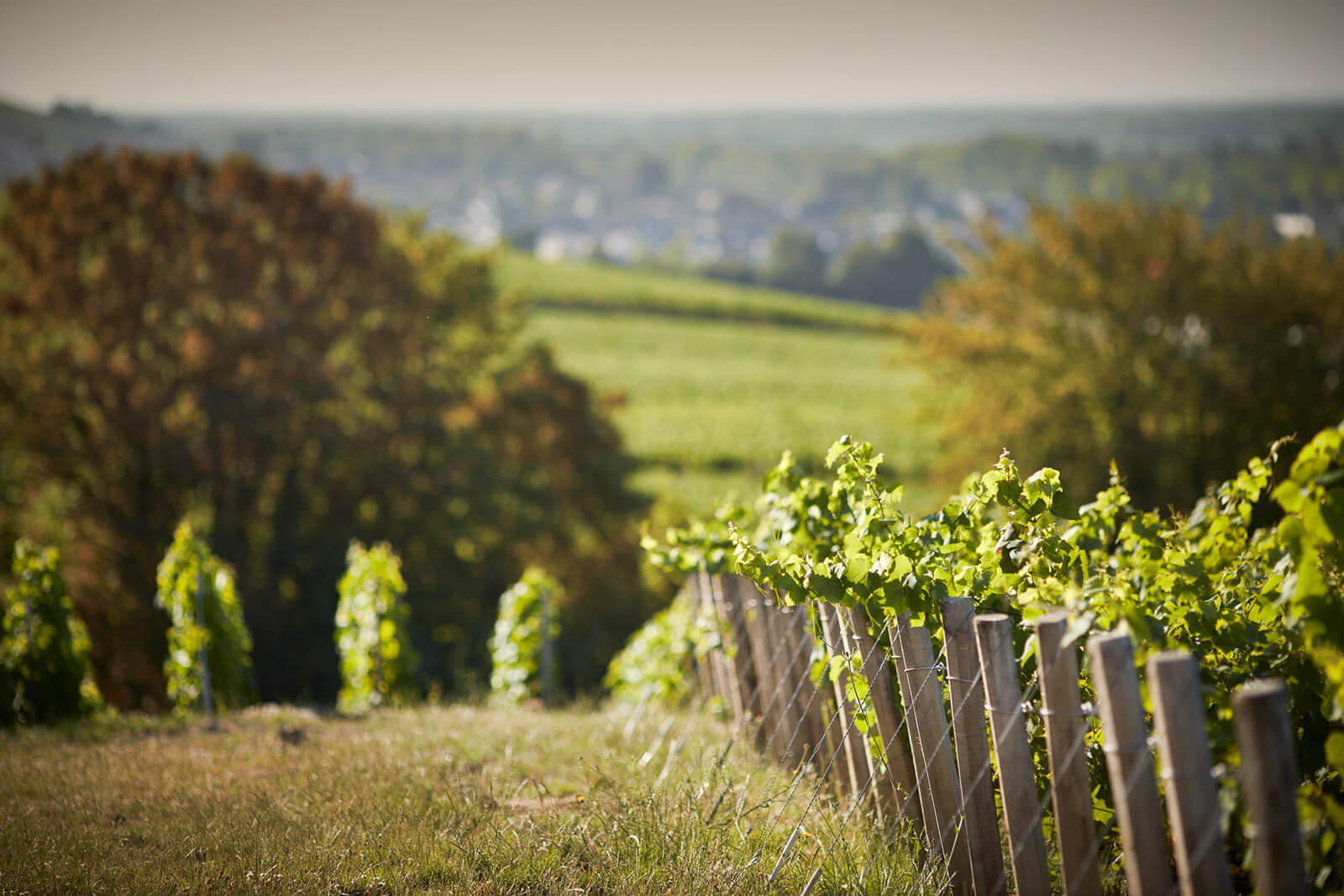
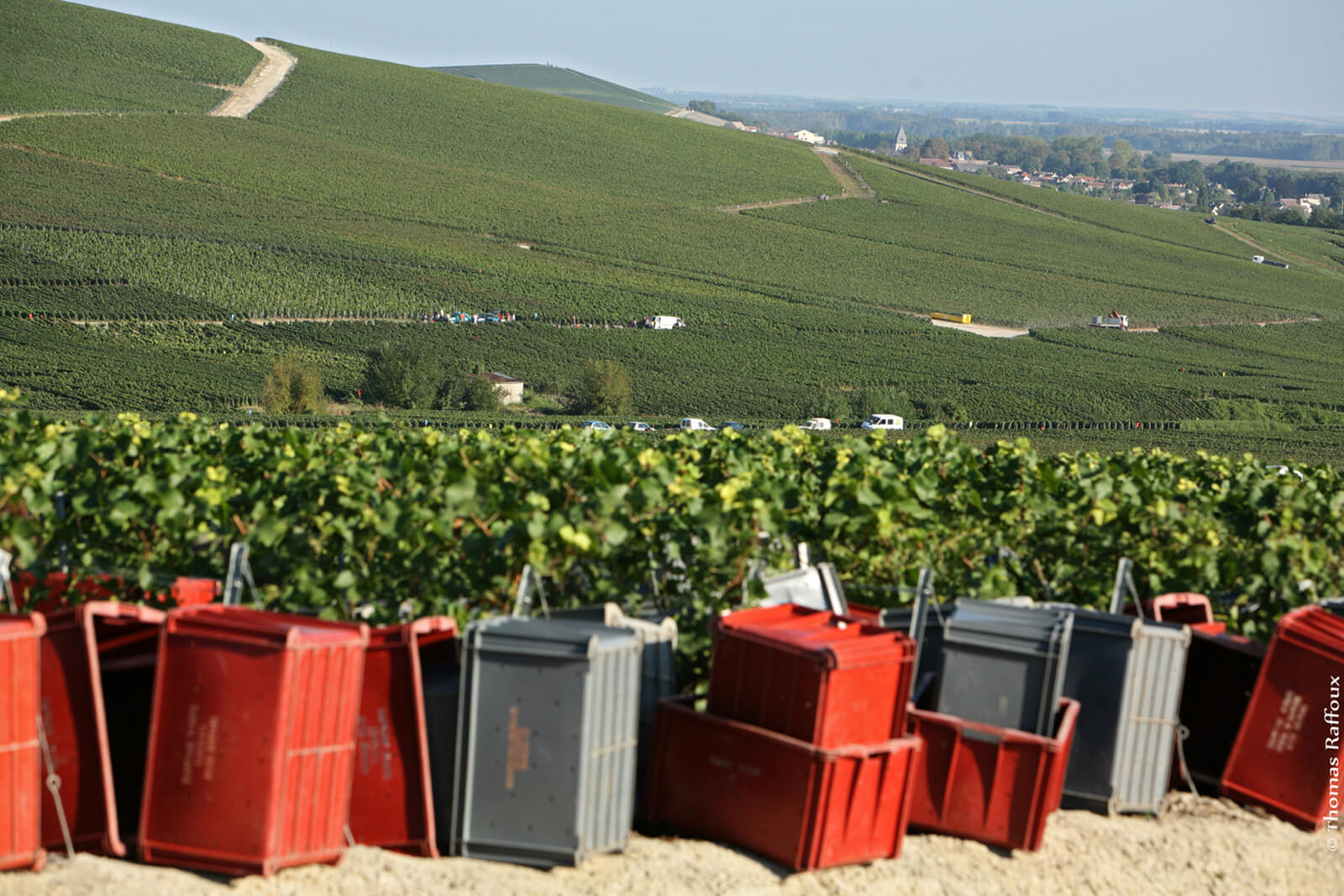
Wings – François Thienpont
Bordeaux, Frankreich
Climatology of the 2020 vintage
1. A mild winter
The very mild temperatures at the beginning of winter heralded an early vintage. With the warming of the soil, the budburst took a head start. The first buds came out homogeneously in mid-February.
2. A rainy spring
Rainfall was extremely heavy from mid-April to mid-May, making this the wettest period in twenty years. In pre-flowering, these conditions, combined with mild temperatures, created strong pressure from mildew and complicated the soil work.
3. A dry and warm summer
Almost two months without rainfall followed one another from the end of June to mid-August, with high temperatures. Water stress in the vineyard remained moderate before the closure of bunches, thanks to the winter and spring recharging of the soil with water, especially on our clay soils. Our white grape varieties, Sauvignon and Semillon, were harvested at the end of August, almost a week in advance.
4. The return of the rain during the harvest
September is marked by dry weather conditions with very high temperatures for the first fifteen days. After the beginning of the Merlot harvest, rain settled down durably around the 22nd. The sanitary state of the vineyard being good, we were able without concern to harvest between the raindrops. The rain was beneficial to our very concentrated grapes which were able to gain in freshness. At the end of September, it was the turn of the Cabernets to be picked.
5. A promising vintage
2020 is marked by concentrated grapes with a high load of tannins and anthocyanins (color), which induces even sweeter extractions than usual in the cellar. The first tastings of the wines in vats are promising: finesse and freshness are there …
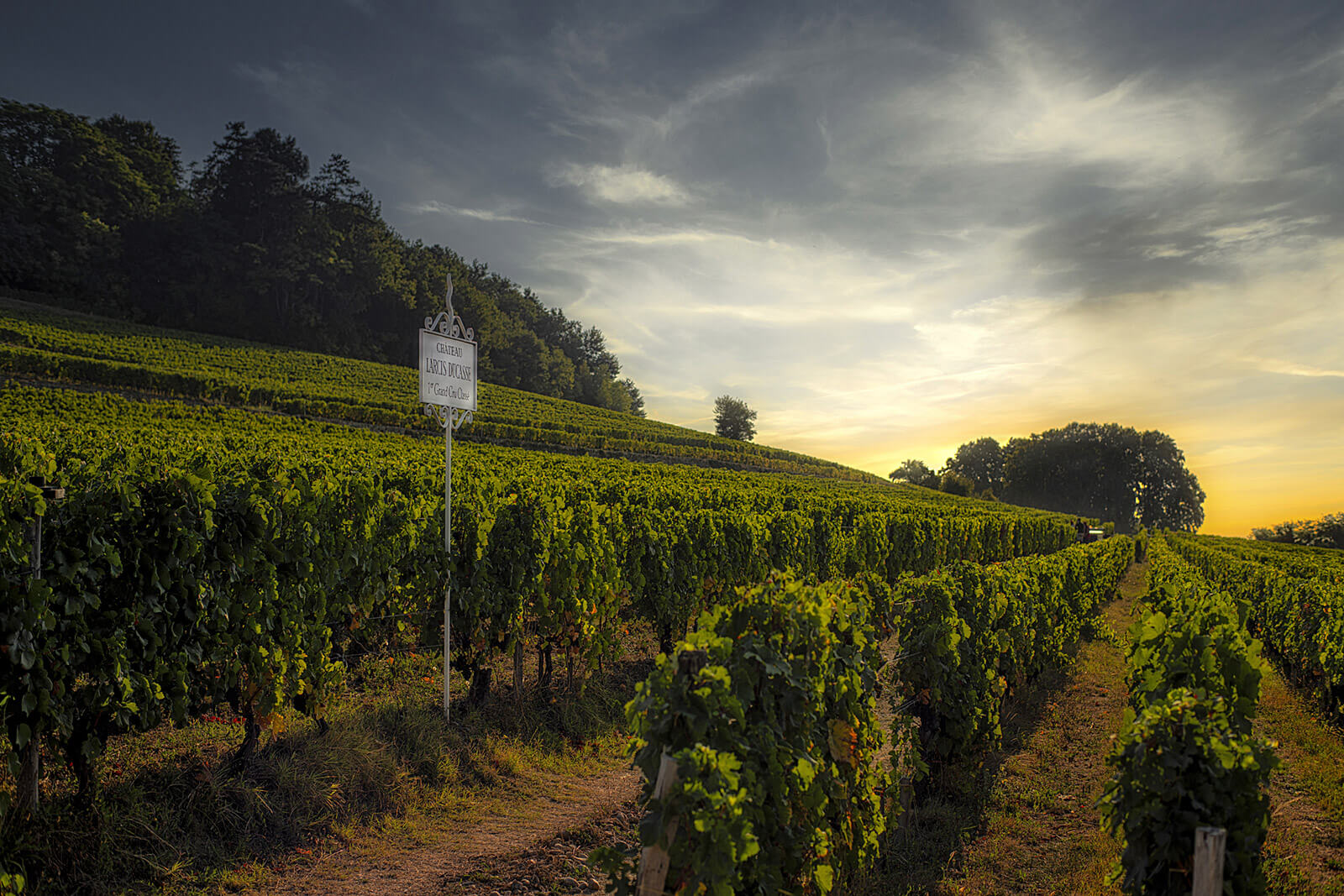
Tasting of the berries. Each year, a grape picking plan is drawn up as the berries are tasted, according to the ripeness of each plot. Managers, technical director, vineyard manager and oenologist meet to taste the grapes together to determine the harvest dates. We are looking for the perfect balance between freshness and aromatic brightness of the fruit. With time, the skins of the grapes become more refined, the aromas develop, the acidity drops, the pips ripen, until they are ready to be harvested.The Larcis Ducasse gravity-cellar was built around 1898. The elders saw it as a way of exploiting the steepness of the hillside and minimizing the handling of the grapes. To each vat will correspond a terroir. Working in parcel-based vinification allows us to develop the personality of each batch. When planning the harvest, the vatting plan and the picking plan are inextricably linked.
Extracting? Made of grape pips and skins, the marc cap formed at the beginning of fermentation contains molecules that carry flavor, color, structure. Several factors favour the extraction of these compounds: the temperature of the vat, the vatting time, the extraction methods, the presence of alcohol… but also the quality of the grapes: thickness of the skins, size of the berries. Method number 1 : Pumping over (Remontage) Pumping over consists in pumping the must or wine from the bottom of the tank to the top. Aerated pumping over can be used to oxygenate the yeasts (necessary for their multiplication and survival) and to extract phenolic compounds. There are also pumping over systems dedicated only to extraction. The pipe is then immersed in the juice. The extraction is done by the juice which crosses the marc.
Method number 2 : Punching down of the cap (Pigeage) Pigeage consists in pushing the cap of marc on the surface into the liquid part of the must, while crumbling it to promote the diffusion of phenolic compounds and aromas. It is a gentle operation, carried out using a pneumatic pigeur at Château Puygueraud, but sometimes undertaken traditionally by hand, as is the case at Château Alcée and Château La Prade. These two methods combine to obtain the desired wine. The program of pumping over and punching down varies according to the characteristics of the vintage.
Laden Sie sich hier den Erntebericht als Pdf herunter
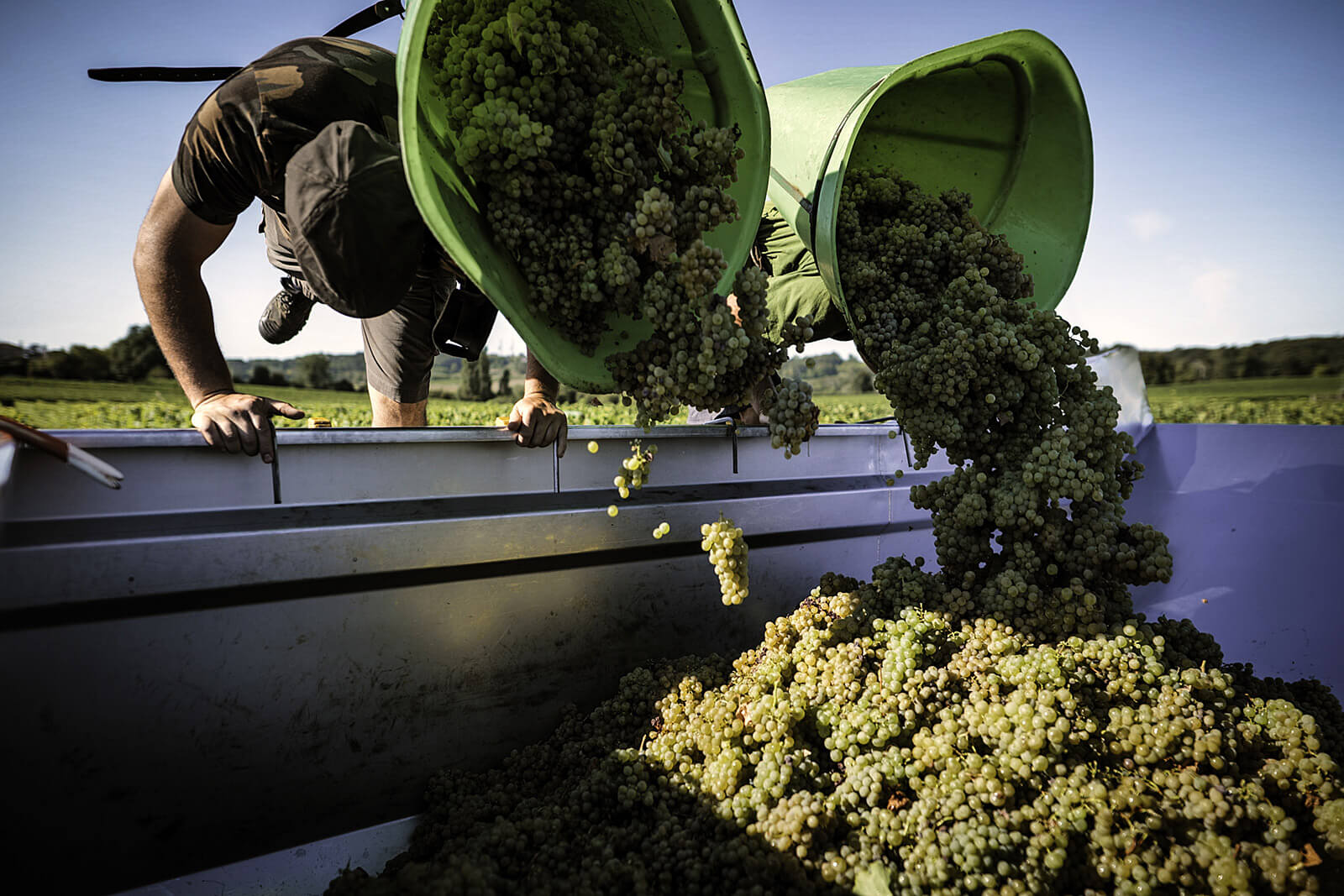
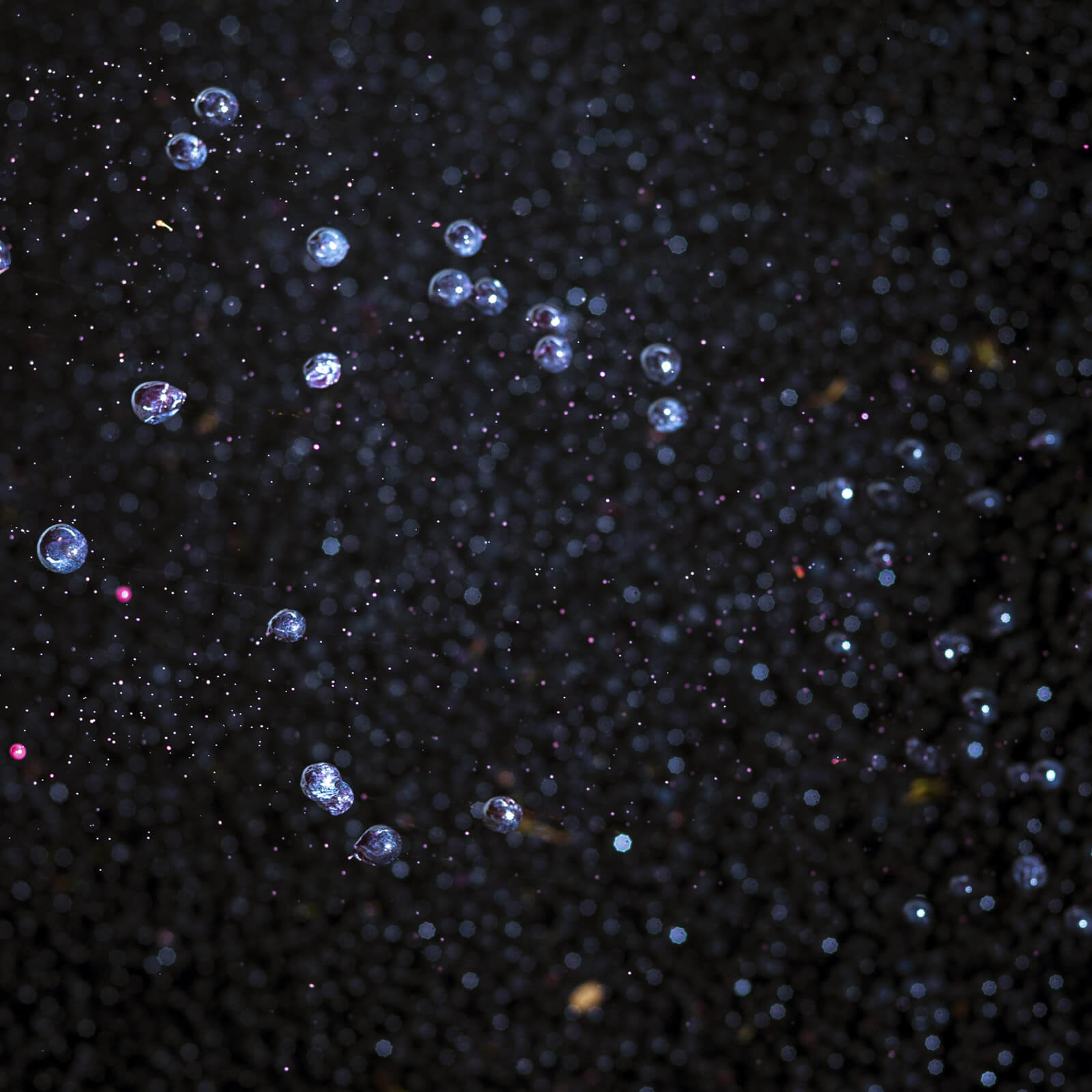
Symington Family Estates
Dourotal, Portugal
Our harvest was defined by two challenges – one immediate and the other more wide-ranging, and ultimately far more concerning. Speaking of challenges, the first people to carve vineyards into the mountainsides of the Douro Valley did so with incredible determination, effort, and grit. And so, it is no surprise that today’s generation of Douro grape farmers and harvest workers, viticulturists and winemakers responded to the challenge of adapting to the covid-19 restrictions with quiet competence and equanimity. At the same time, they successfully navigated yet another vintage defined by the ever-more-present tests that the climate crisis is throwing at us.
Our reward for growing grapes in such an inaccessible, low-yielding, and expensive region is that we get to spend our days in an area of stunning beauty, we get to work with exceptional people, and we get to produce outstanding wines and ports that have this amazing valley in their DNA.
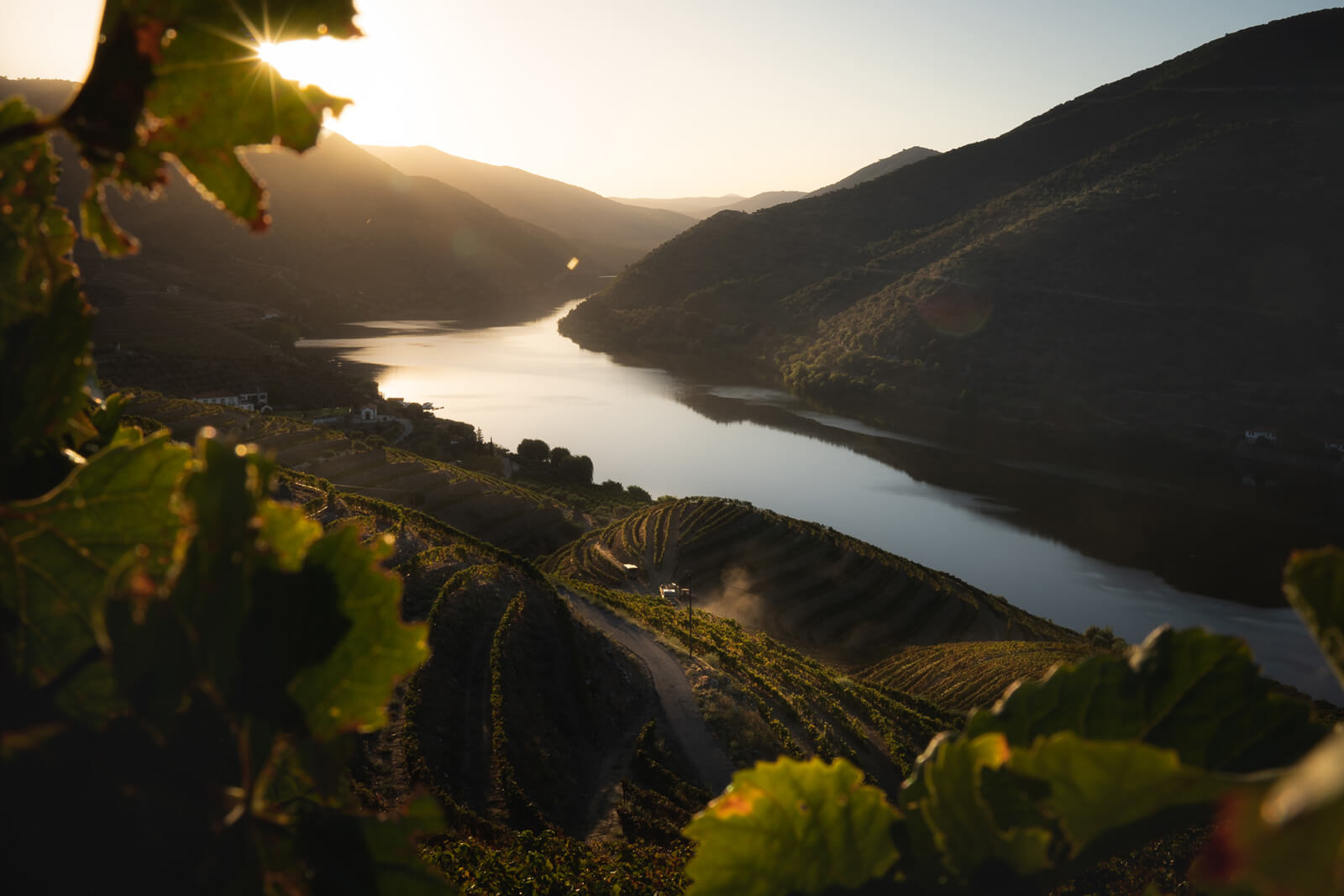
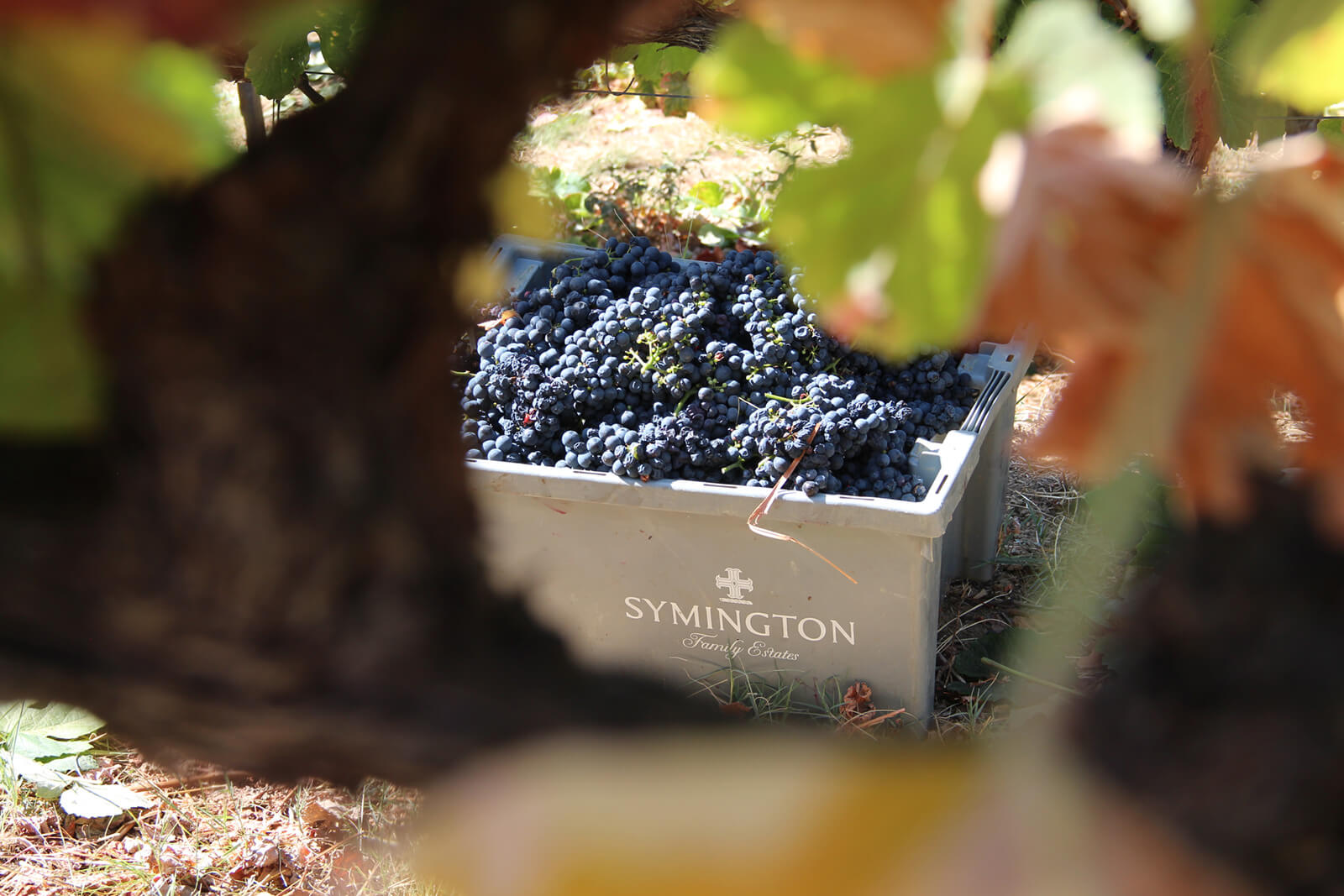
The impact of coronavirus
As we only get one shot at the vintage, it was essential that we minimised the risk of covid infections. We implemented a wide-ranging plan to create protective bubbles around the teams. This included testing for every winery worker, many health and safety measures on site, and additional accommodation and canteen facilities to ensure safe levels of social distancing.
This was the first year since we acquired Quinta do Vesúvio in 1989 (and the first year since the winery was built in 1827) that no grapes were foot-trodden in the large granite lagares at the property. Much comment is made about how foot-treading produces superior ports to other methods – and we would agree that this is true in the case of conventional fermentation tanks and plunger mechanisms in stone lagares, which are the techniques of choice in most Douro wineries.
However, in our case, we use modern treading lagares, which we designed ourselves in the late 90s. These consist of silicon pads which actually tread the grapes, simulating the action and temperature of human feet, providing fantastic levels of colour, aroma and flavour extraction. We only adopted this technique once we were convinced that, as proved by rigorous blind tastings, they consistently produced ports as good as – if not better than – those made with foot-treading.
A precocious growing cycle
Although we have weather stations at various quintas in the Douro Superior and Cima Corgo, we typically use Dow’s Quinta do Bomfim at Pinhão in the heart of the region as a barometer for the overall conditions in the Douro. This year, winter and early spring rainfall readings were roughly in line with the average. However, higher-than-average temperatures (with a particularly warm February, at least 2°C warmer than the 30-year average) caused the vines to emerge from their winter slumber three weeks earlier than usual, with budbreak recorded at Quinta do Bomfim on March 3rd. Flowering also arrived two weeks earlier than normal, beginning on May 5th.
Worrying signs of warming
If the overall rainfall levels for 2020 were reassuring, the temperatures were far from it. At Bomfim, every month apart from April was considerably warmer than the 30-year trend. The Douro experienced the hottest July on record, 3.5°C above the average for the region. We also had heat waves in June, August, and September which registered multi-day spikes above the 30-year average maximum temperatures (see charts below). According to IPMA (Instituto Português do Mar e da Atmosfera), the period from January to mid-September 2020 was the warmest on record. Globally, climate scientists think 2020 might end up being the hottest year on record (16 of the 17 warmest years since records began in 1850 have happened since 2000).
The good news is that our indigenous varieties are well adapted to hot and dry Douro summers and demonstrate a variety of natural responses to challenging conditions (including reducing berry and bunch sizes and slowing down maturation). There is also much we can do – and are doing – to adapt to these conditions, from basic techniques around canopy management (and using vineyard layout, altitude and aspect in our favour), to innovations regarding ancestral varieties, climate forecasting software, vineyard robots, and vine water stress studies. However, consistently high temperatures (above 35°C), are – without a doubt – a problem for the region.
Juggling the picking schedule
Due to the advanced growing cycle, we were already on track for an early harvest. With virtually no rain in June or July, we were pleased to see 12.6 mm fall at Bomfim on 20th August (generous pre-harvest rainfall is often an important contributor to the best Vintage Port years in the Douro). Unfortunately, the rain was followed by three waves of high temperatures lasting until mid-September. With the heat counteracting the benefit of the water – and faced with the threat of berry dehydration – we began picking white grapes (which were in remarkably good condition) from the 25th August and we started harvesting our red grapes in earnest on 1st September. The summer heatwaves meant that by early September, yields were substantially reduced compared to our July forecasts (up to 40% downwards in some properties). Although a smaller harvest helps with the complicated logistics of grape-picking in the Douro (predominately picked by hand and with frequent labour shortages), this year’s conditions saw varieties that usually ripen sequentially, needing picking at the same time. This was particularly so with the typically late-ripening Touriga Franca, which we decided to pick at the same time as the Touriga Nacional. This is not a common occurrence. Nevertheless, our experienced vineyard teams adapted exceptionally well, so that the wineries received each variety in the best possible condition. The Douro is a low-yielding region even in the bumper years, but 2020 has brought us an especially small crop. In some locations in the Douro Superior we were harvesting only 400g per vine. Quinta dos Malvedos, the primary Graham’s Port estate, averaged just 600g per vine. Our normal yields per hectare are x4 times less than many other wine regions. When you factor in the high costs of farming our mountain vineyards, it is no wonder that the only viable and responsible future for the Douro involves selling our fantastic wines and ports at the upper end of the market.
The upside
Fortunately, our reward for navigating these challenges has been that the unsettlingly low yields resulted in some incredibly concentrated and dark wines. My first impressions – confirmed by subsequent tastings – were of particularly promising lagares with balanced Baumés. A comparable harvest is 2009, which was also a very dry and hot year, with low yields that nonetheless delivered small quantities of intense, well-structured wines and ports. The stand-out has been the Touriga Nacional, which has produced wines with excellent structure and good acidity. This is remarkable, given the conditions. The Sousão also performed well. The Alicante Bouschet and Touriga Franca were slightly more impacted by the high temperatures, although they did deliver very good quality from more protected slopes and higher elevations. I am pleased with the impact that Sousão and Alicante Bouschet have had on our top ports in recent years, giving us colour, acidity and structure – which is especially important in hot conditions. The fact that the Douro’s terroir provides such a variety of microclimates is a massive advantage in a year like 2020. It takes a rare constellation of events for quality to be consistently exceptional throughout the region (as was the case, for port, in 2011, 2016 and 2017), but the investments we have made in our vineyards and wineries over recent decades mean that we have much greater capacity than previous generations to produce small quantities of stunning Douro wines and ports, even in such challenging conditions as were thrown at us this year.
Looking to the future
All of us in the Douro are concerned about climate change. As the Mediterranean climate shifts northwards, we face an increase in average temperatures, lower rainfall levels, and more frequent temperature spikes. Although our grape varieties are resilient – and we have been preparing for climate change for many years – more needs to be done to help grape farmers to adapt (including widespread research into vineyard strategies, responsible and sustainable irrigation policies). And, to safeguard the future of wine production in the Douro, we need to see a far more ambitious reduction in global CO2 emissions this decade. At Symington, we are measuring our end-to-end carbon footprint and, as members of International Wineries for Climate Action, are signed up to ambitious reduction goals based on the scientific consensus of safe levels of emissions.
Charles Symington
Winemaker – Production Director
Quinta do Bomfim, Douro Valley – Wednesday 7th October 2020
Photography project – This year we had a photographer-in-residence working with us at Dow’s Quinta da Senhora da Ribeira in the Douro Superior. You can view Francisco Soares’s digital exhibition, ‘The People Behind the Harvest’, consisting of 45 stunning portraits (each accompanied by a short caption or story), here on Instagram: @senhora.da.ribeira_2020.
Laden Sie sich hier den Erntebericht als Pdf herunter
